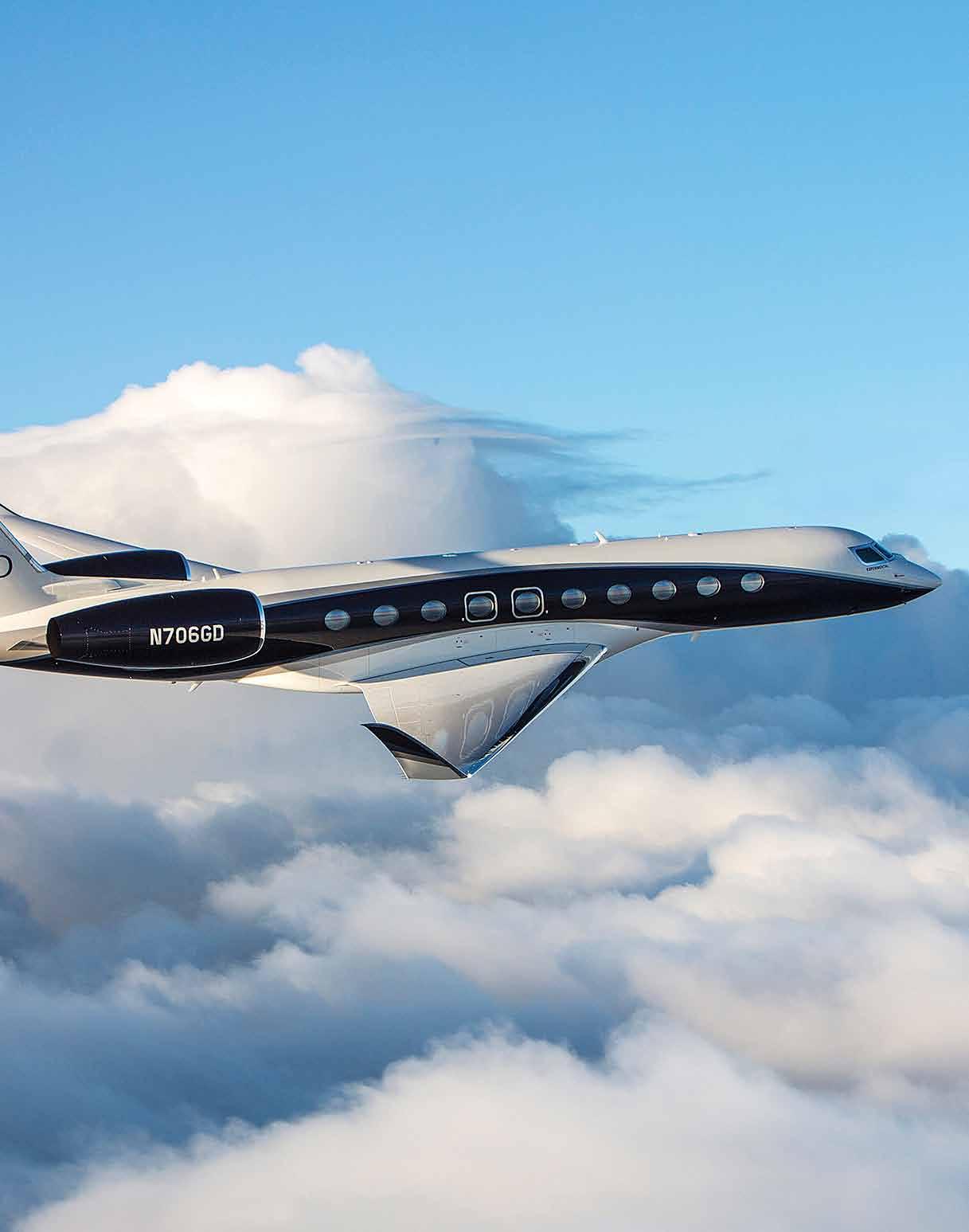


An SP Guide PublicAtion RNI NUMBER: DELENG/2008/24199 vol 25 ISSUE 11 • 2022 SP’s ` 100.00 (Ind I a-ba SE d b U y E r only) www.sps-aviation.com aviation PAGE 8 Military Indo-French e xerc I se Garuda VII Business aviation a Breath o F c lean, Fresh aI r The G700 (in fliGhT) by GulfsTream is on world Tour ThaT was announced on ocTober 17Th. The jeT is flyinG To souTh america, europe, africa, asia and ausTralia as well as The evenTs includinG middle easT & norTh africa business aviaTion associaTion (mebaa) show in dubai. Sharp Content for a Sharp a udien C e MEBAA R eturns AftEr A hiAtus of 2 yEArs, MiddlE EAst’s lEAding BusinEss AviAtion EvEnt is BAck with A BAng EnABling thE MEEting of rEgion’s BA/gA coMMunity LAST WORD t ra I n I n G I s V I tal & c r I t I cal
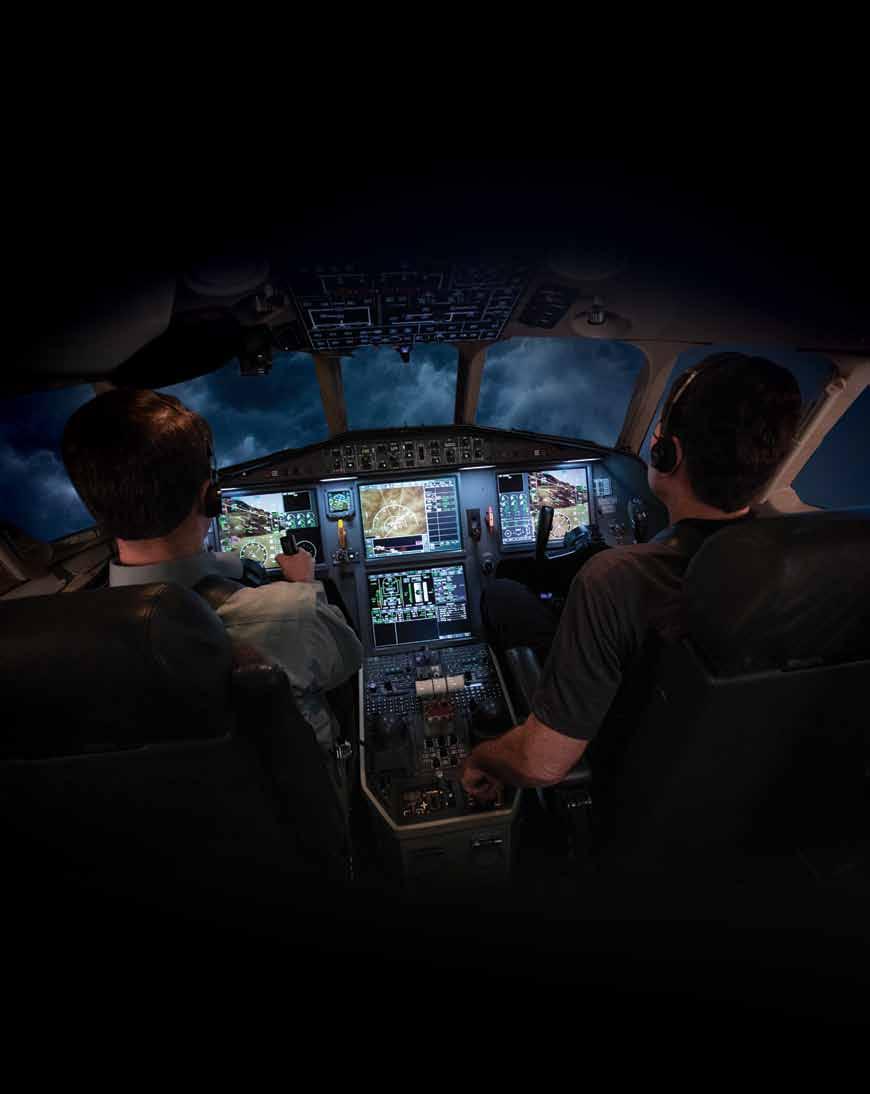
P R O FI C IENT I S C A P ABL E . P R E PA RE D I S UN S HAKABLE . Ther e ’s tr a i n i n g to c heck a b ox an d tr a i n i n g for excellenc e Whe n tr a i n in g to meet a req u ireme n t , the re s ult is proficie nc y Whe n crew tr a in with th e b est to b e the b e s t skill s are s h a rpene d , prep a ri n g them for a n ything I t ’s li ke thi s : Proficie n t is c ap ab l e Prepared is u ns haka b l e Do yo u w a nt yo u r pilo t to be pro fi c ie n t or prepare d ? Call +1.201.584.8262 today or visit FlightSafety.com
Publisher And editor-in-Chief
Jayant Baranwal
dePuty MAnAging editor Neetu Dhulia
PrinCiPAl CorresPondent Ayushee Chaudhary
Contributors
India: Air Marshal Anil Chopra (Retd) Group Captain Joseph Noronha (Retd) Europe: Alan Peaford USA & Canada: LeRoy Cook ChAirMAn & MAnAging direCtor Jayant Baranwal PlAnning & business develoPMent Executive Vice President: Rohit Goel
MAnAger – hr & AdMin Bharti Sharma dePuty MAnAger – CirCulAtion Rimpy Nischal grouP reseArCh AssoCiAte Survi Massey reseArCh AssistAnt Sarthak Baranwal design
Holistic Directions: Jayant Baranwal Sr. Designer: Vimlesh Kumar Yadav, Designer: Sonu S. Bisht grouP direCtor – sAles & MArketing Neetu Dhulia dePuty direCtor – sAles Rajeev Chugh
sP’s websites Sr Web Developer: Shailendra P. Ashish Web Developer: Ugrashen Vishwakarma
© SP Guide Publications, 2022
Subscription/Circulation
Annual Inland: `1,200 • Foreign: US$320 E-mail: subscribe@spguidepublications.com subscribe@sps-aviation.com
LETTER TO EDITOR editor@sps-aviation.com; expert@sps-aviation.com
For Advertising details, contact: neetu@spguidepublications.com rajeev.chugh@spguidepublications.com
SP GUIDE PUBLICATIONS PVT LTD
A-133 Arjun Nagar, (Opposite Defence Colony) New Delhi 110003, India. Tel: +91 (11) 24644693, 24644763, 24658322 Fax: +91 (11) 24647093 E-mail: info@spguidepublications.com
Representative Office
MOSCOW, RUSSIA
LAGUK Co., Ltd., (Yuri Laskin) Krasnokholmskaya, Nab. 11/15, app. 132, Moscow 115172, Russia. Tel: +7 (495) 911 2762 Fax: +7 (495) 912 1260


table
neXt issue: Business Aircraft Financing
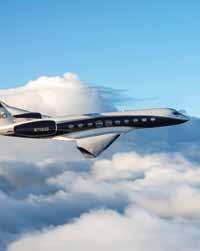
1 ISSUE 11 • 2022 www.sps-aviation.com Civil 4 Regional Connectivity Untapped Potential Business AviAtion 8 MEBAA 2022 Back with a Bang! 12 Passenger Safety A Breath of
Fresh Air 18 G700
engines 15 OEM
oeM 22 Technology Future of Flight — Powered
GE MilitAry 25 Exercise Garuda VII Indo-French
VII 27 Airshow
China’s Display
Might regulAr DepArtMents 2 A Word from Editor-in-Chief 30 Hall of Fame Bring on the Boeings! 31 NewsDigest 32 Last Word Training is Vital & Critical Cover
showings
customers
Clean,
Gulfstream Announces G700 World Tour
A Mammoth Partnership Powering Aviation World
by
Exercise Garuda
China 2022
of Military
Gulfstream G700 is on a world tour, flying to major events and private
across 20 cities and six continents as part of the company’s efforts to give
direct access to the aircraft.
Cover Photo: Gulfstream Cover Design By: SP’s Team
vol 25 ISSUE 11 • 2022
of C ontents
Awards 2017 Special Contribution to business AviAtion RNI NUMBER: DELENG/2008/24199 VOL 25 ISSUE 11 2022 SP’s 100.00 (INDIA-BASED BUYER ONLY) www.sps-aviation.com aviation PAGE 8 MILITARY INDO-FRENCH EXERCISE GARUDA VII BUSINESS AVIATION A BREATH OF CLEAN, FRESH AIR THE G700 (IN FLIGHT) BY GULFSTREAM IS ON WORLD TOUR THAT WAS ANNOUNCED ON OCTOBER 17TH. THE JET IS FLYING TO SOUTH AMERICA, EUROPE, AFRICA, ASIA AND AUSTRALIA AS WELL AS THE EVENTS INCLUDING MIDDLE EAST & NORTH AFRICA BUSINESS AVIATION ASSOCIATION (MEBAA) SHOW IN DUBAI. SHARP CONTENT FOR A SHARP AUDIENCE MEBAA R eturns AFTER A HIATUS OF 2 YEARS, MIDDLE EAST’S LEADING BUSINESS AVIATION EVENT IS BACK WITH A BANG ENABLING THE MEETING OF REGION’S BA/GA COMMUNITY LAST WORD TRAINING IS VITAL & CRITICAL
MEMBER / PARTNER OF
www.spguidepublications.com
our lead story in this issue is on the return of the in-person MEBAA show, with a bang, in Dubai from December 6-8, 2022. Promising an unmatchable experience of the exhibition hall, chalets and aircraft display located in one convenient location- The MEBAA Show 2022 offers a unique opportunity for the BA/GA fraternity to meet, view, learn and network with the Who’s who of the region’s private and business aviation community. MEBAA Show is showcasing the latest cutting-edge and innovative solutions. Executive Lifestyle along with the latest in digital platforms for business and private aviation, blockchainbased assets, eVTOL aircraft and the most advanced technologies, there will be plenty on display for all types of users of business aircraft. Ayushee Chaudhary brings a report on what can be expected at the show.
Business Aviation saw a significant growth over the last couple of years, as passengers shifted to flying private due to safety concerns. The COVID-19 pandemic has placed health, safety and sanitisation at the forefront of the entire customer experience. As travellers return to the skies, in an article in this issue, Rohit Goel looks at some of the initiatives taken and the developments underway to provide Clean and Fresh air to passengers on private aircraft.
Earlier this year, Ministry of Civil Aviation’s flagship program Regional Connectivity Scheme UDAN completed 5 years of success since the launch of it first flight by Prime Minister on April 27, 2017. More than one crore passengers flown since the inception of the scheme which has seen 425 New routes started; 58 airports, eight heliports and two water aerodromes have been connected and now a 1,000 Routes and 220 airports are planned to be facilitated under the scheme by 2026. Perhaps the biggest beneficiary of this RCS UDAN is the North-East Region (NER) of the country which always was cut-off from the rest of the country due to limited connectivity. In an article in this issue, Sanjay Bhatnagar covers how, under RCS, numerous airlines have started flights to various cities in the NER, various
airports and other aviation infrastructure have been developed and now a perceptible growth in the region can be seen due to increased and better connectivity.
Aviation is highly technology based and the entire flying experience of the passengers is driven by aviation technologies. From the first commercial flight onwards, the adventure of flying on a plane has undergone a sea change, all thanks to newer technologies which are making air travel smoother, safer and seamless. One company that is on the forefront of developing technologies for the future of flight is General Electric (GE). In the pursuit of Net Zero emissions and innovations, the company is working on some break-through technologies. This issue includes a report by Joseph Noronha on GE’s road map towards the Future of Flight.
The 14th Chinese International Aviation and Aerospace Exhibition, also known as the Airshow China was held in the port city of Zhuhai, China from November 8-13, 2022. The Chinese defence industry put out a bewildering array of weapons, vehicles, helicopters and aircraft as they seek to meet the needs of the rapidly modernising People’s Liberation Army and to capture lucrative export markets. Rohit Goel brings the show report in this issue.
All this and more in this issue of SP’s Aviation. Welcome aboard and we wish you many happy landings!
Owned, published and printed by Jayant Baranwal, printed at Kala Jyothi Process Pvt Ltd and published at A-133, Arjun Nagar (Opposite Defence Colony), New Delhi 110003, India. All rights reserved. No part of this publication may be reproduced, stored in a retrieval system, or transmitted in any form or by any means, photocopying, recording, electronic, or otherwise without prior written permission of the Publishers.
Jayant Baranwal Publisher & e ditor-in-Chief

Follow us on

a word from editor-in-chief 2 ISSUE 11 • 2022 www.sps-aviation.com
@SPsAviation
SPPublications
MEBAA is back with a bang! Set to take place in Dubai from December 6-8, 2022, the show will bring together Operators and Leaders from the Business Aviation Industry for three days of insightful discussions, industry announcements and significant networking opportunities
A FORCE WITH NATUR
E2. THE WORLD’S MOST EFFICIENT SINGLE-AISLE AIRCRAFT
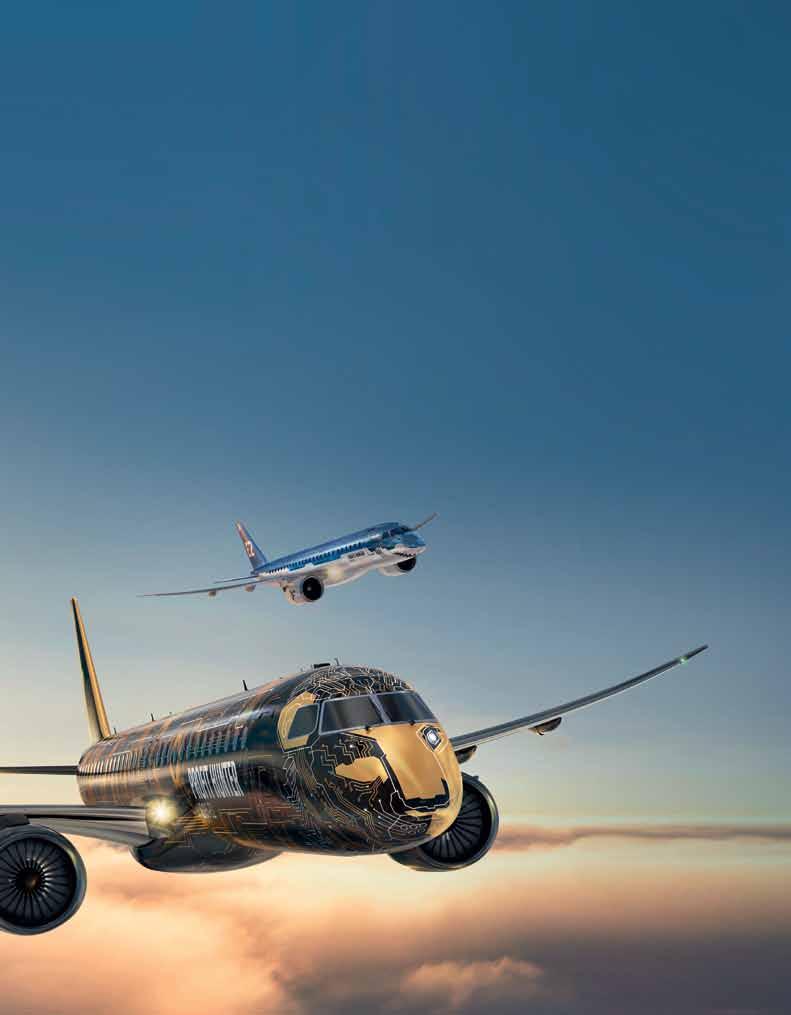
Lower fuel burn and emissions. Extremely quiet inside the cabin and outside. The most efficient aircraft in single-aisle. When it comes to environmental friendliness, the E2 is a force with nature.
#AForceWithNature
untapped potential
Regional Connectivity Scheme (RCS) is a Golden Story of development in the North-East Region of the Country under the Government’s UDAN initiative
By Air Vice MArshAl sAnjAy BhAtnAgAr (retd)
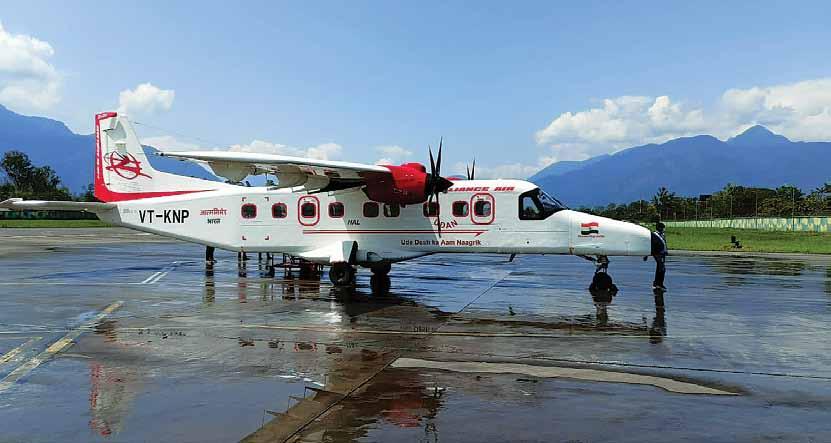
North-East is a distinct region. it is an ethically, culturally and geographically diverse region. The Northeastern region (NER) comprises of eight, by and large hilly states–Arunachal Pradesh, Assam, Mizoram, Meghalaya, Manipur, Tripura, Nagaland and Sikkim. The region shares international borders of 5,812 km with the neighbouring countries of China, Bangladesh, Nepal, Bhutan and Myanmar. The 60 km long and 22 wide Siliguri Corridor (called Chicken’s Neck) connects the northeastern states to the rest of India. This region represents a huge untapped potential in regional connectivity in India.
The NER is endowed with rich natural resources such as oil and natural gas and agro and forest-based products. The Region is a major producer of tea and possesses one-third of the country’s hydro-power potential. The scenic surroundings also provide an ideal setting for the promotion of the tourism industry. There is thus a dire need to develop economy of the region in tourism and organic produce sectors.
Improvements in connectivity and infrastructure, across the world has prodded the states into connectivity hubs, leading to fast paced development in all sectors of economy. While there
4 ISSUE 11 • 2022 www.sps-aviation.com Civil Regional ConneCtivity
p ho T ograph: aai o fficial / Twi TT er
The ‘Made in india’ dornier aircrafT now provides air connecTiviTy To five reMoTe Towns of arunachal pradesh and furTher boosT air connecTiviTy of norTh-easTern region wiTh resT of india
are a lot of infrastructure development initiatives being progressed in the region, gestation period is very long. Work for Bogibeel Road-Railway Bridge, connecting Dhemaji district and Dibrugarh district on river Brahmaputra, started in 2002 and took nearly 200 months to complete. Airlines thus continue to be the fastest and most efficient mode to provide connectivity.
Air connectivity is critical to the North-East from a strategic and development perspective. Thus, a special boost needs to be given to improve connectivity in the North-East. The NorthEast’s integration with the rest of the country via air links is very much part of India’s look east policy.
In order to enhance air connectivity within various Tier-II and Tier-III cities, Ministry of Civil Aviation (MoCA) has launched its flagship RCS UDAN scheme. It is termed as Regional Connectivity Scheme UDAN (Ude Deshka Aam Nagrik). It has completed 5 years since the launch of it first flight by Prime Minister Narendra Modi on April 27, 2017. The scheme was initiated on October 2, 2016 with a noble objective to fulfil the aspirations of the common citizen by following the vision of ‘Ude Deshka Aam Nagrik’.
RCS-UDAN was formulated based on the review of National Civil Aviation Policy (NCAP)-2016 and is planned to remain in force for a period of ten years.
It has a self financing mechanism. Under the RCS UDAN Scheme, RCF was created, which caters for Viability Gap Funding (VGF) requirements of the scheme through a levy on certain domestic flights, so as to keep the fares affordable and accessible for the common people. This way, funds generated from the avi-
RCS AiRpoRtS & RCS RoutES
iN NoRth-EASt REgioN (NER)
Tripura nil rcs airport 6 rcs routes
Mizoram nil rcs airport 2 rcs routes
Manipur nil rcs airport 2 rcs routes nagaland dimapur 8 rcs routes arunachal pradesh passighat, Tezu 6 rcs routes assam jorhat, lilabari, Tezpur rupsi 30 rcs routes Meghalaya shillong 15 rcs routes
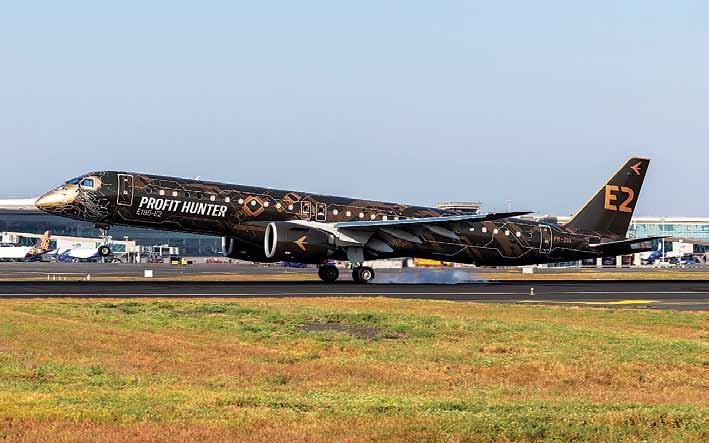
ation sector themselves stimulate the growth and development of the sector. Put simply, it entices airlines to fly to un-served and under-served airports to connect all parts of the country.
Following the three successful rounds of bidding, the Ministry of Civil Aviation (MoCA) had launched the fourth round of UDAN in December 2019 with a special focus on North Eastern Regions, hilly states, and islands. The awarding of these new routes under UDAN 4 has been in line with the Act East Policy of the Government. Presently, RCS UDAN has operationalised 70 airports, against the target of 100 airports by 2024 (including 9 heliports and two water domes). At the national level 449
5 ISSUE 11 • 2022 www.sps-aviation.com
Regional ConneCtivity
Civil
MuMbai inTernaTional airporT (csMia) welcoMed The sTunning e2 which Made Maiden grand enTry in MuMbai, recenTly. eMbraer e2 is one of The Major poTenTial conTribuTors in building india’s regional connecTiviTy.
p ho T ograph: cs M ia
RCS routes are operational and as on date more than a crore passengers have flown on these routes.
The Prime Minister Narendra Modi inaugurated Donyi Polo Airport, near Itanagar (Arunachal Pradesh) on November 19, 2022. Work on the airport has been completed within a period of 32 months, despite the challenges due to the COVID-19. Prime Minister said, “Donyi Polo Airport will be the fourth operational airp ort in Arunachal Pradesh, taking the total count in the northeast region to 16”.
According to published reports, NER has witnessed the highest growth rate in aircraft movement in August 2022 compared with the same month in 2017, an increase of 36 per cent from August 2017 to August 2022 (total of 7,973 flights). By comparison, growth was five per cent in the airports of the North and South regions, 14 per cent in the East and 0.5 per cent in the West. Guwahati has emerged to be the busiest airport in the region with 3,498 aircraft movements, followed by Agartala (Tripura) at 1,052. It is interesting to note that air connectivity to Shillong (Meghalaya), Dimapur (Nagaland), Dibrugarh and Lilabari (both Assam) has seen higher rate of growth than other airports in the region.
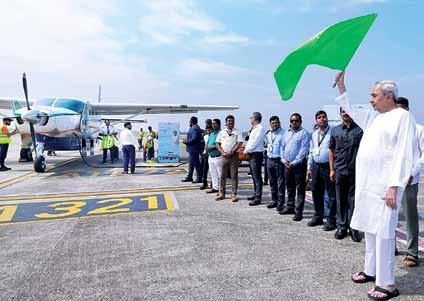
Reports indicate that Assam has gained maximum from the RCS UDAN scheme with four RCS operationalised airports at Jorhat, Lilabari, Tezpur and Rupsi and 30 RCS routes. Meghalaya with its single RCS airport at Shillong has added 14 routes. Arunachal Pradesh has operationalised Passighat and Tezu airport and a total of six RCS Routes. Nagaland has operationalised Dimapur airport and added eight RCS routes. Manipur, Mizoram and Tripura may not have added any RCS airports so far but, Manipur and Tripura have six RCS routes each and Mizoram has two RCS routes; Sikkim has its Pakyong RCS airport and six RCS routes.
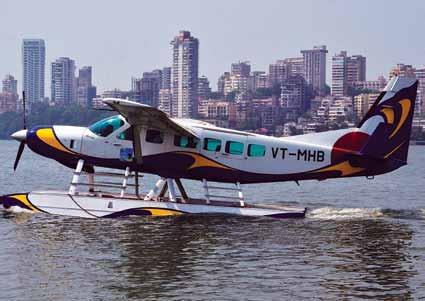
The credit for progress should go to the initiative taken by major airlines and the interest that they have shown in the economic progress of the region. IndiGo, one of the largest airline by market share, considers NER to be of strategic importance. Of the total of 90 RCS routes operationalised by IndiGo across the country, 18 are in NER. Alliance Air has operationalised a total of 95 RCS routes nationally, of these 14 are in NER. Big Charter has operationalised a total of 90 RCS routes nationally, of these 16 are in NER. SpiceJet has taken the lead of operationalising all six routes from Pakyong in Sikkim. Big Carrier has also embarked upon its NER operations by taking on 16 routes in the region. These newly operationalised RCS routes provide connectivity within the NER airports as well as to cities outside the region including Kolkata and Delhi.
While the passenger traffic in the region is picking up, there is also a great amount of potential for growth of cargo traffic in the region, perishable fruits being grown in the region, viz organic
produce from Sikkim and organic ginger from Tripura etc have international market. Air connectivity of cargo to Kolkata and from there to European market would provide a big boost to economy of the region. In the past five years, Imphal (Manipur) has registered a 61 per cent increase in terms of load carried.
NER as a region is strategically important to the country and is looking up to a fast paced increase in air connectivity. Considering the growth potential of economy riding on regional air connectivity, all the stakeholders- the state governments, MoCA, regional airlines and various states and local commerce bodies are actively taking initiatives towards coordinating for mutually beneficial solutions. RCS has brought NER to an interesting phase in its growth, next few years are important. SP
6 ISSUE 11 • 2022 www.sps-aviation.com
Civil Regional ConneCtivity
p ho T ographs: aai o fficial / Twi TT er, M ehair
(Top) new airlines flying sMaller regional aircrafT are coMing up in india in supporT of The udan scheMe; (above) seaplanes can be effecTively used for connecTing Tier-ii and Tier-iii ciTies locaTed near waTerways.
At GE, we have the spirit, the ambition and the means to help achieve the industry’s commitment to net-zero by 2050.
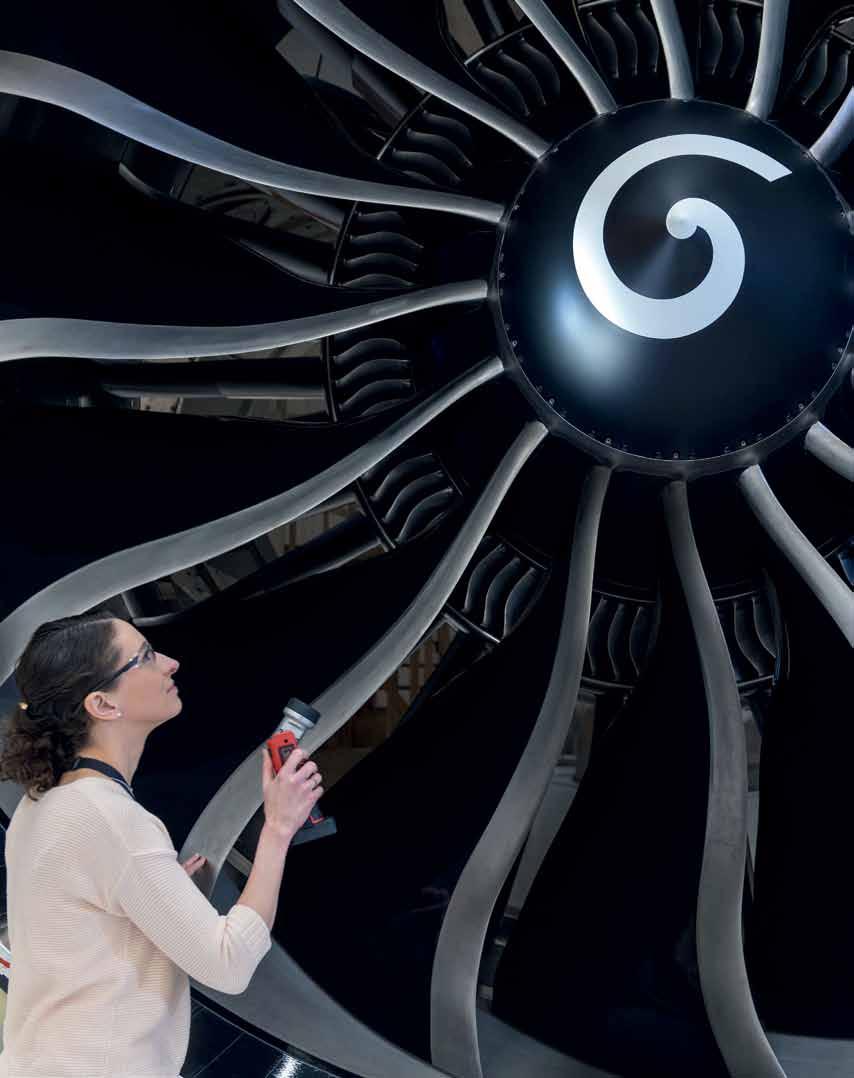
Leveraging highly innovative technological advancements, our people are relentless in their pursuit of decarbonization to keep operators, defense forces, and global commerce moving forward.
See what we’re doing today for the benefit of us all tomorrow.
GEtoNetZero.com
Because we believe the world works better when it flies.
The biggest challenge demands our greatest commitment.
Back with a Bang!
MEBAA Show 2022 is gearing up to take place in Dubai at DWC, Dubai Airshow Site from December 6-8, 2022
By Ayushee ChAudhAry
every aviation show is a melting pot of various aspects of the industry from all across the globe and before the year ends a coming together of business aviation industry is taking place in Dubai. After a halt of two years, the Middle East & North Africa Business Aviation Association (MEBAA) Show 2022 is set to take place in Dubai at DWC, Dubai Airshow Site from December 6-8, 2022, bringing together regional and global players from across the business and private aviation community. Themed “Leading the way for business aviation”, the show will bring together industry operators and leaders for three days of insightful discussions, industry announcements and significant networking opportunities. This is the 9th edition of the show which will include new high-tech and ultra-luxurious jets, blockchain-based assets, eVTOL (electric Vertical Take Off & Landing) aircraft and several new and exciting features. The show is gearing up to be a key event for the region’s business aviation industry and will gather industry leaders from across the globe to lay
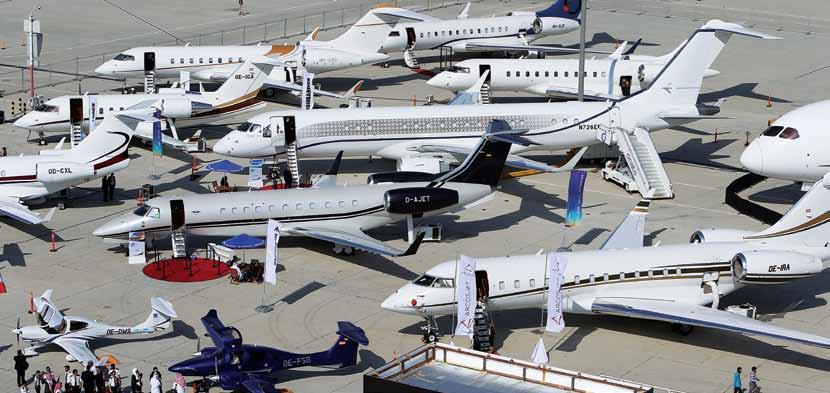
out the roadmap for business aviation in the future. With global events like Dubai Expo, FIFA World cup and extensive promotion of tourism, the Middle East region’s aviation industry has seen positive activity. By 2037, the Middle East and Asia-Pacific are expected to be the fastest growing markets, with an annual RPK growth rate of 5.7 per cent, according to Embraer Market Outlook 2018. Bombardier predicts 350 deliveries to the Middle East valued at $12 billion over the next 10 years.
Ali Ahmed Alnaqbi, Founding and Executive Chairman of MEBAA, commented, “The business aviation industry has seen remarkable growth over the last few years, and this has opened up huge opportunities for innovation. With less than a few weeks to go, the entire community is looking forward to this major event in the business aviation industry that offers the ideal platform to showcase new technologies and solutions, network with industry leaders and tap into the latest trends that are shaping the future of business aviation. We look forward to
8 ISSUE 11 • 2022 www.sps-aviation.com Business AviAtion MEBAA 2022
p hotograph: mebaa
(File photo) a line-up oF business aircraFt at mebaa
welcoming representatives from across the sector and working together to take business aviation to new heights.”
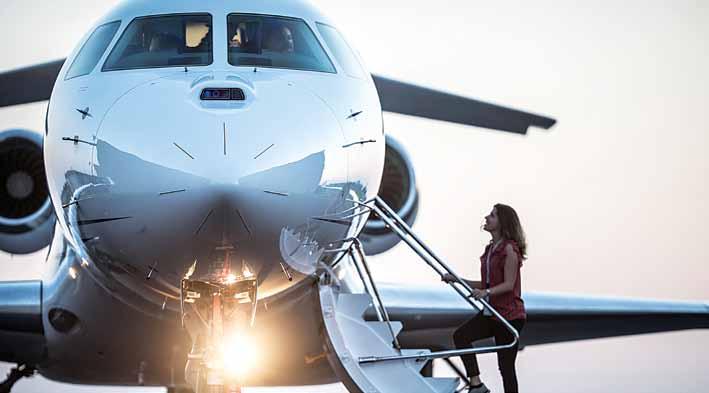
Offering a look at the facts and figures shaping the industry, Alnaqbi will present ‘Emerging markets forecast - accessing the top countries who are contributing to business aviation growth’, highlighting the regional trends that are vital for businesses to operate in the Middle East. There will also be a forward-thinking panel discussion on ‘creating the ultimate flying experience for the elite’, with a focus on how travel expectations are changing and what business aviation will look like in the next 20 years.
MEBAA 22 show will see the launch of its brand-new conference, BizAv Talks with over 20 sessions, more than 35 global industry leaders and specialists deepdive into the latest trends shaping the future of business aviation. Through a series of presentations, panel debates and interviews, elite players in their field will cover key themes including future aviation, sustainability, emerging markets and regulations, as well as reassess the dynamics of the industry and offer a new perspective on business aviation and how technology can enhance the customer experience.
With ‘Air Mobility’ and ‘Sustainability’ in private aviation at the top of the agenda for the industry, significant focus is expected to be on green issues and sustainability in private aviation, discussing best practices to meet green goals while protecting ROI. Dedicated sessions will also discover how eVTOLs
are changing the way of flying and identify how business aviation can capitalise on Advanced Air Mobility technology, calculate ROI and accelerate investment to enable a move into Urban Air Mobility networks.Business aviation industry outlook including new business models and financial planning; alternative business models for bizav; financing, leasing, & fractional ownership; critical observation of global bizav trends will also be discussed.
What to ExpEct at MEBaa ShoW 2022? MEBAA Conference
The conference aims to discuss the future of private jet business models as aircraft owners are reassessing traditional business models to match this new era of aviation. As demand for private jets increase and customer expectations develop, it is paramount that business aviation stakeholders evaluate methods, product offering, value-added services and revenue sources to ensure they reach their new target customers. There has been a shift in passenger behavior as well and that demands a modification of the next-generation customer. Collaboration within the ecosystem is necessary to help streamline services and value creation, however the importance of cross-industry collaboration for tackling the biggest issues facing business aviation is critical. What technology can be used in business aviation to boost passenger confidence, how can aircraft owners
9 ISSUE 11 • 2022 www.sps-aviation.com Business AviAtion MEBAA 2022
Ali Ahmed Alnaqbi, Founding and Executive Chairman of MEBAA, commented,
“The business aviation industry has seen remarkable growth over the last few years, and this has opened up huge opportunities for innovation.”
p hotograph: Dassault a viation
unrivaled comfort and efficiency: Dassault aviation Falcon 8X will be on Display at the show
diversify and tap into new opportunities, are some of the questions that the conference will aim to answer.
During the MEBAA show Richard Koe, Managing Director of WINGX Advance GmbH, will be presenting the latest statistics and analysis on the Middle East business aviation market, with a specific focus on the KSA and UAE. Commenting ahead of this he said: “Business aviation demand in the Middle East and North Africa has seen an unprecedented upturn in the last few years. Particularly in the Gulf Region, the rapid policy response to the pandemic enabled an early exit from lockdown and created a haven for tourism during the pandemic in 2021. The region appears to be realising its long-term potential as a global gateway for trade, commerce and tourism between Asia, Africa and Europe, and business aviation is clearly playing its part. At WINGX we have seen a rapid acceleration in business jet connections with Africa, Asia and the CIS region, in addition to the more mature links with European cities. We look forward to discussing these trends at MEBAA in December.”
As the next major event in the global business aviation calendar, the MEBAA Show 2022 will offer a platform to discuss the latest trends and showcase new aircraft and technologies shaping the business aviation industry, including eVTOLs, digitalisation, tokenisation and crypto-based payments. This year’s show will also welcome more than 20 new exhibitors, with Executive Lifestyle, Tahseen, Ecommpay, VOO, Mirai Flights,
Liberty Aviation, Prime Trip Support, Flight Consulting Group, AAL AG (Altenrhein Aviation) and AAS AG (Atlas Air Service) set to attend.
Putting innovation at the forefront, several new aircraft will be on display on the immersive show floor including the Boeing – 737, Dassault Aviation - Falcon 8X, Bombardier Aerospace - Global 7500, Gulfstream Aerospace Corporation - G700, Embraer - Praetor 600 and Phenom 300E and many more.
Aircraft Display
At the MEBAA show, the latest Business Aviation aircraft from major manufacturers and OEMs including Dassault Falcon, Embraer, Gulfstream, Bombardier and more on display. The 2022 edition will showcase an extensive range of small jets and bizliners to the latest electric planes and eVTOLS from leading aircraft manufacturers. Some of the aircraft on display at the show will be:
Bombardier: Global 7500
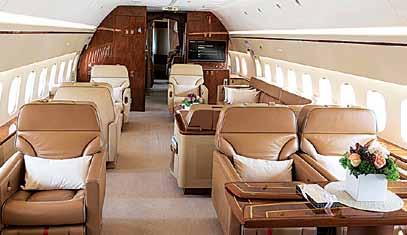
Comlux: SkyLady Boeing 767-200ER
Dassault: Falcon 8X
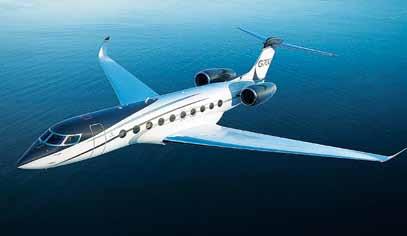
Gulfstream: G700 and G650ER
Embraer: Praetor 600 and Phenom 300E
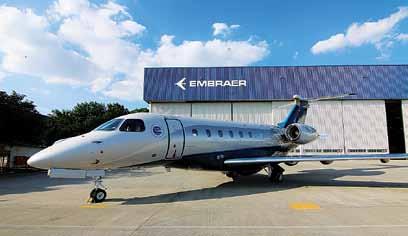
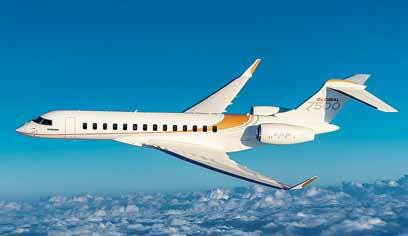
Boeing: 737
Royal Jet: BBJ 737-700
Airbus: ACJ320neo
ASM FZE: Learjet 60XR SP
10 ISSUE 11 • 2022 www.sps-aviation.com Business AviAtion MEBAA 2022
•
•
•
•
•
•
•
•
•
best of business aircraft will be on display at mebaa:
p hotographs: b ombar D ier, g ul F stream, e mbraer, royaljet
(clockwise From top leFt) bombarDier global 7500; gulFstream g700; embraer praetor 600; boeing business jet 737-700 by royal jet

A BreAth of CleAn, fresh Air
For the safety of the passengers on a private jet flight, the air quality is very carefully controlled, with recent advances making it even more clean and fresh
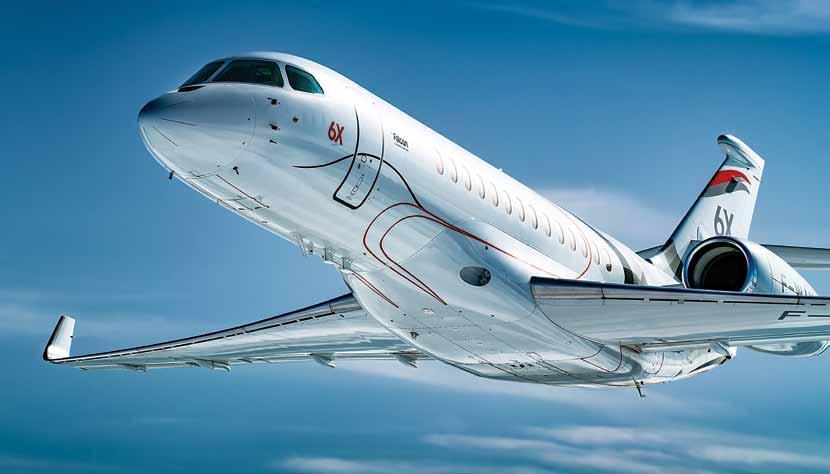 By Rohit Goel
By Rohit Goel
the air we breathe – particularly in an enclosed space – has a huge impact on our health and wellbeing. Cabin air quality on an aircraft carries the risk of communicable diseases transmission. The overall risk of contracting a disease from an ill person onboard an airplane is similar to that in other confined areas for a similar time of exposure.
During the COVID-19 pandemic, there was a significant shift towards flying private to avoid getting infected. However, how
clean is the cabin air on a private jet? Given the enclosed nature of an aircraft cabin, some people worry that it is somehow more prone to holding onto pathogens or viruses than a larger or naturally ventilated space. But that’s not necessarily the case, especially in a private jet. On a private jet flight, the air quality is very carefully controlled, with recent advances making it cleaner still. There are a number of ways to ensure high quality cabin air on a private jet, but most private jet aircraft fall into one of two catego-
12 ISSUE 11 • 2022 www.sps-aviation.com Business AviAtion Passenger safety
p hotograph: Dassault a viation
Dassault Falcon 6X has Fresh air Filtration system ensuring that passengers will arrive at the Destination Feeling reFresheD
Business AviAtion Passenger safety
ries – 100 per cent fresh air systems or recirculated air systems.
In a 100 per cent fresh air system, air from the outside is brought in through the engines on a continuous basis, then compressed and sterilised before it enters the cabin. Vents and valves are used to extract air out of the cabin at the same time –typically resulting in the cabin air being replaced entirely every two minutes. As the air being brought in is continually refreshed, the circulation minimises the spread of viruses and bacteria.
Some private jets recirculate air within the cabin, which provides for better humidity control and temperature control. A recirculated aircraft air system still takes in some fresh air but then mixes it with air already in the cabin that is cleaned before being re-used. The proportion of recirculated to fresh air can vary from aircraft to aircraft, as does the speed at which the cabin air is replaced.
Some private jet aircraft manufacturers have introduced HEPA filter systems, which capture bacteria, viruses and other particles, before air is recirculated. A HEPA filter captures a minimum of 99.97 per cent of contaminants at 0.3 microns in size. These are the same filtering systems that are used in hospitals and other environments where sterile air is a priority.
CLEAN AIR, SAFE TRAVEL
Aviation Clean Air’s (ACA) NeedlePoint Bi-Polar Ionisation process is proven to immediately purify the air and surfaces and neutralise pathogens throughout the aircraft interior. ACA’s airborne and ground units stop the spread of up to 99.9 per cent of airborne and surface pathogens, including COVID-19, and are available for all models of business and commercial aircraft. The NPBI process also removes odours, dust and pollen, sterilises mould, neutralises common industrial gases and reduces static electricity. The system provides constant decontamination of the aircraft interior without using or introducing chemicals.
are insufficient with marginal impact. CTT offers humidifiers and dehumidifiers for absolute control of humidity in an aircraft. CTT is the leading producer, designer and supplier of products that solves the humidity paradox in aircraft. Available for retrofit and line-fit on commercial aircraft as well as private jet completions, Humidifier Onboard is improving wellbeing and wellness in flight deck and crew rests on more than 1,000 widebody commercial airliners and close to 100 VIP aircraft. This highly appreciated climate feature has started to migrate to the premium passenger cabin and large-cabin, long-range business jets.
Cabin climate is key to the overall experience. A cabin climate optimised for wellbeing is all about replicating earth conditions. Temperature and humidity control is important. Extremely dry cabin air in a private jet cabin is not doing any good for passenger wellness and wellbeing. Modern large-cabin business jets have made great progress in lowering cabin altitude, reducing noise and vibrations, generating draft-free and fresher air, multiple temperature zones and advanced mode lightning. Humidity is the biggest deviator to what we are used to and built for. A significant increase of humidity is required to improve the performance of the cabin and elevate the total cabin environment experience.
Aerometrix can provide airlines with key information regarding air quality, ventilation efficiency, equipment health monitoring and many other operational parameters
The ACA Component is not a filter. The ACA Component electronically creates positive and negative ions from Hydrogen and Oxygen molecules in the water vapor present in the air. This replicates natures’ cleaning process with nothing else added. These ions have the property of clustering around micro particles, gases, airborne mould spores, viruses and bacteria. As this occurs, a natural reaction takes place on the cell membrane surface of airborne biological(s) where they rob the harmful biological of a hydrogen atom. As a result, the pathogens are inactivated, and odours are disassembled naturally. The pathogen will not be able to reproduce and will quickly die and the odours are converted to virtually pure air thereby eliminating the threat of the pathogens and odours to human health and comfort.
The Airborne Air & Surface Purification System is added to the existing environmental control system (ECS) and works whenever the system is on during all ground and flight operations. With ACA’s Airborne System constantly purifying the cabin air and surfaces, passengers can safely and comfortably conduct business as usual.
HUMIDIFIER ONBOARD A PRIVATE JET
A VIP aircraft and a large-cabin bizjet requires active humidification from a high-performance system as all passive means
Elevated humidity makes us feel better. We are always looking for the ways to differentiate. Innovation is experience centric. And experience comes through the senses. Anytime airlines can get more senses involved, the better. That transforms the experience to become more sensory. We feel, sleep and taste better. Arriving more ready to go. Less impacted from jetlag. Humidifier Onboard empowers wellbeing and transforms the dried-out cabin into one in which all cabin products and services can be experienced at their best. With air humidity at a ground-equivalent level, passengers stay hydrated and feel more balanced and at ease. A coveted VIP-passenger priority – sleep – also improves. VIPs arrive at their destination richer due to a better, richer and more sensory experience that leaves them refreshed, rested and ready to perform.
MONITORING AIR QUALITY ONBOARD
AEROMETRIX is the first global service to monitor passenger comfort, air quality and cabin systems on board aircraft. Covarians, a company that specializes in Internet of Things programmes for aviation, has launched a cabin air quality monitoring service.
The world service “Aerometrix” monitors air quality, passenger comfort and other environmental parameters. Aerometrix is based on a range of non-intrusive stand-alone sensors that can be installed without the need for aircraft modification, according to Covarians. The service provides airlines with information on thermal comfort, air quality, ventilation efficiency, equipment condition monitoring and many other operating parameters. Although modern aircraft generate giga bytes of data after each flight, very few relate to cabin environmental conditions and passenger’s experience. Introducing new sensors in aircraft requires a complex and costly modification process. Aerometrix is based on non-intrusive autonomous sensors installed on board the aircraft and connected to a data processing and
13 ISSUE 11 • 2022 www.sps-aviation.com
analytics cloud. Aerometrix can provide airlines with key information regarding air quality, ventilation efficiency, equipment health monitoring and many other operational parameters. Covarians said its goal was “to make cabin air quality monitoring an affordable reality for airlines and passengers”.
“To ensure good measurement it is necessary to position the sensors at the most air quality representative spots within the cabin,” the company added. “Very often these spots are in plain sight of passengers so the sensors have to be as discreet as possible and match the finely crafted cabin style. Bearing all these requirements in mind, this is exactly what Covarians has achieved with Aerometrix sensors.” This has been a four-year long development programme with extensive experimentation. Over the past years Aerometrix sensors have flown more than 22,000 hours in regular passenger flights.
A HOSPITAL-HONED TECHNOLOGY
The Cabin Air Purification System (CAPS) from Villinger is now available for business jet operators to achieve purification and disinfection on board. It is based on patented LEA air disinfection technology, developed in close collaboration with virologists and medical engineers for improved air disinfection in hospitals during the pandemic. Villinger shares that in performance testing, executed by FDA-certified laboratory Aerosol Research & Engineering Labs, LEA achieved a microbial reduction rate of 99.99992 per cent of airborne viruses. “This proves CAPS’ capability to not only remove airborne pathogens and pollutants, but also inactivate them instantly,” says Markus Villinger, CEO at Villinger. “Doing so, CAPS operates without the formation of by-products such as ozone or NOx.”
CAPS is designed to have no considerable impact on the airflow rate within the air ducts, which Villinger says is a “large
advantage over conventional filtration measures, such as HEPA”. LEA achieved the highest reduction rate he has seen in that short amount of time compared with conventional technologies such as UV or ionisers.
Depending on aircraft type and model, the required number of CAPS units is calculated by Villinger specialists prior to system integration, to achieve the best possible safety and hygiene.
GULFSTREAM DOUBLES DOWN ON CABIN AIR PURIFICATION
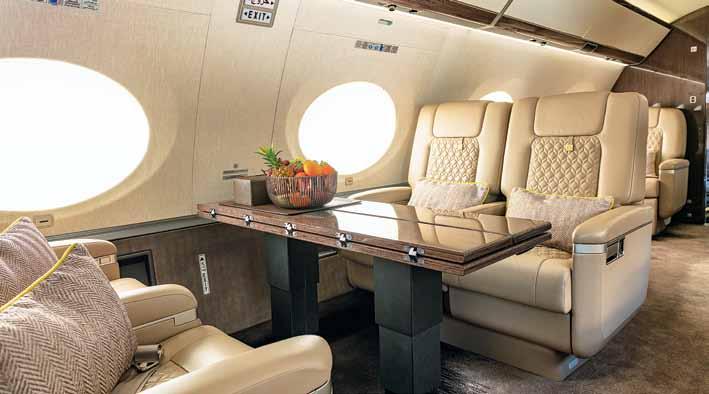
Gulfstream has further invested in customer health through plasma ionisation. The air purification system, which complements Gulfstream’s already 100 per cent fresh-air environment, has proven in lab tests to kill pathogens and allergens. Gulfstream’s plasma ionisation system, which operates whenever the aircraft environmental control system is active, works by emitting positive and negative oxygen ions that actively seek out and inactivate harmful molecules in the air and on surfaces. This process neutralises particulate matter — not just bacteria and viruses, but also unpleasant odours from organic material like cigarette smoke.
“The addition of the plasma ionisation system further enhances the cabin health benefits customers can expect from the signature Gulfstream Cabin Experience,” said Mark Burns, President, Gulfstream. “By adding such a system in tandem with already 100 per cent fresh air and the proven Gulfstream airflow design, customers can fly their families and teams with even more peace of mind.”
Even when running solely on an auxiliary power unit, the system produces thousands of ions throughout the entire aircraft, ensuring that cabin air remains pure and surfaces are disinfected while aircraft are prepared by pre-flight caterers, cleaning crews and FBO technicians alike. SP
14 ISSUE 11 • 2022 www.sps-aviation.com Business AviAtion Passenger safety
p hotograph: Qatar eX ecutive
Qatar eXecutive has a Fleet that contains a uniQue Filtration system that regularly pumps 100% Fresh air into the cabin
OEM
a mammoth partnership powering aviation world
In April this year, CFM International surpassed 50,000 CFM LEAP and CFM 56 engines sold to over 600 customers around the world
By Ayushee ChAudhAry
since its creation in 1974, CFM international, the 50/50 joint-venture between GE Aviation and Safran Aircraft Engines, has been an important player in the commercial aviation industry. CFM, CFM56, LEAP, RISE and the CFM logo are trademarks of CFM International that have taken the company to be among world’s leading suppliers of commercial aircraft engines. 48 years ago Safran Engines and GE Aviation partnered to create CFM, producing the largest fleet of commercial jet engines with innovation and sustainability in mind. In April this year, CFM International surpassed 50,000 CFM LEAP and CFM 56 engines sold to over 600 customers around the world, accumulating over 1 billion engine flight hours.
45 years ago in 1977, CFM 56 made its first flight, and ten years after that in 1987, it was the first flight of the Airbus A320 powered by the CFM56 engine. Within a few years, the CFM565B became the engine offered on the entire A320 family. CFM has produced and delivered the world’s largest fleet of jet engines in the single-aisle market. To support unprecedented production rate, as CFM parent companies, both GE Aerospace and Safran Aircraft Engines have added new manufacturing capability at sites throughout the US and France, making a combined capital investment of more than $1 billion since 2005.
The advanced CFM LEAP engine continues to set new industry standards for fuel efficiency and asset utilisation, accumulating more than 23 million engine flight hours and 10 million cycles in commercial operation. The fleet is providing 15 to 20 per cent better fuel consumption and lower CO2 emissions, as well as a significant improvement in noise compared to previous generation engines. Since its entry into service in 2016, the LEAP engine allowed operators to save more than 15 million tonnes of CO2 and the LEAP engine has surpassed 20 million flight hours while the LEAP-1A engine alone has logged over 12 million flight hours. On its way to engine certification, CFM pushed its LEAP test programme to the limit. To meet the performance and reliability expectations made to its customers, a total of 60 LEAP engines were built to execute the most extensive ground and flight test certification programme in the company’s history. The LEAP-1A, LEAP-1B and LEAP-1C engine models have all been jointly certified by EASA and FAA.
At the Farnborough International Airshow (FIA) this year, GE announced becoming the first to successfully test high
power, high voltage hybrid electric aircraft engine components at simulated altitude conditions. The technology GE is advancing “will help make hybrid electric flight a reality for everyday commercial air travel, and it should have a real and necessary impact on the carbon emissions associated with flying”. Specifically, GE and NASA ran a megawatt-class, multi-kilovolt hybrid electric system in conditions simulating altitudes up to 45,000 feet. Single-aisle planes could account for 70 per cent of the world’s rapidly growing commercial aviation fleet in the near future.
The company underlines, with aviation accounting for about 2.5 per cent of global CO2 emissions, hybrid electric propulsion technologies could help bring the number down. Hybrid electric technology is also compatible with Sustainable Aviation Fuel (SAF) and hydrogen, and with proposed, more efficient engine
15 ISSUE 11 • 2022 www.sps-aviation.com EnginEs
A provEn globAl support nEtwork is AlrEAdy in plACE 60+ Customer Support Managers 250+ Global Field Service Engineers 5 Training Centers on 3 Continents 3 Customer Support and Diagnostics Centers CFM intErnAtionAl — A HigHly suCCEssFul vEnturE 115+ Facilities $1+ Billion Total Capital Investment in state-of-the-art manufacturing facilities 1.5 Million + Square Feet added by GE and Safran Aircraft Engines to make LEAP Engines Production Ramp-Up 2023: +2000 engines objective
Creation of CFM International
On September 24, the official founding of CFM International, as a 50/50 joint company.
First Order
On March 29, United Airlines announces an order to reengine 30 Douglas DC8-71 jetliners with the CFM56-2.
CFM: 20 MilEstonEs
March: First CFM56powered Boeing 737 Takes place in March 1984,powered by the CFM56-3, specially developed to reengine the 737
CFM Powers Airbus

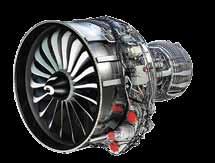
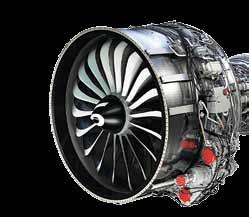
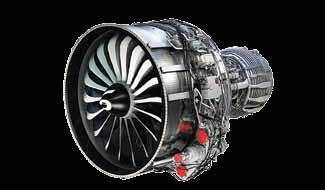
The CFM56-5A logs its first flight on an A320 on February 22, 1987

Boeing Confirms Boeing chooses the CFM56-7 in 1993 as the exclusive engine for the NextGeneration 737.
1000 engines a year CFM reaches the threshold of 1,000 engines per year
1974 1979 1984 1987 1999 1977 1982 1991 1997
First Flight
The CFM56 made its first flight on a Caravelle flying testbed on March 17, 1977.
April 1982: Entry into Service
The first commercial flight of a CFM56 takes place on April 24, 1982.

December: The Ramp-up begins 300 CFM56 engines were delivered in 1984.
Unprecedented Production
Nearly 900 CFM56 engines (-2,-3 and -5) are delivered in 1991.
1993
First flight of Boeing 737 NG The first flight of a CFM56-7Bpowered Boeing Next-Generation 737 jetliner takes place in February 1997.
CFM56
Source: CFM
designs ensuring 15 per cent improvement in fuel consumption and CO2 emissions, compared to CFM56 engines.
4,300 CFM LEAP engines have been delivered to the customers, flying an average of 10 hours a day and up to 11 flight cycles, every day. This has also made way for more uptime and less downtime as well as a higher utilisation of 96 per cent which means more flights & more flexibility to fly when and how you want. Additionally, supporting 25-minute gate turnaround times, which means less time at the gate and more flying. The engine uses 90 miles per gallon per passenger, delivering 20 per cent fuel efficiency, flying with LEAP uses 66 per
cent less fuel. It also opens up new routes, supporting longer flight legs, enabling flight options of eight hours or more. The engine is 3-D woven and has also proven to be aerodynamically efficient. The LEAP engine’s fan blades are manufactured from 3-D woven RTM (Resin Transfer Molding) carbon fiber composites, an industry first for CFM. This technology results in fan blades that are not only lightweight but so durable that each individual blade is strong enough to support the weight of a wide-body airplane like the Airbus A350 or Boeing 787. The LEAP engine is the first engine to use additive manufacturing to “grow” complex, fully dense yet lighter engines. Its fuel
16 ISSUE 11 • 2022 www.sps-aviation.com EnginEs OEM
Source: CFM
EnginEs Aircraft Engines Operators Hours Cycles
CFM56-2A E3/KE3/E6 41 193 4 2,907,425 1,194, 938 CFM56-2B KC/RC135 470 1,966 5 28,740,285 8,634,932 CFM56-2C DC8-70 110 525 Out of Service 16,348,980 6,927,353 CFM56-3 B737-300/-400/-500 1,989 4,496 297 225,881,887 159,904,943 CFM56-5A A319ceo/A320ceo 535 1,191 50 62,939,837 36,160,575 CFM56-5B A318ceo/A319ceo/A320ceo/A321ceo/ACJ 4,188 9,091 218 256,452,633 146,170,258 CFM56-5C A340 247 1,133 36 74,341,584 11,002,791 CFM56-7B B737-600/-700/-800/-900/BBJ 7,089 15,211 256 469,578, 917 242,324,614 Total 14,669 33,806 670 1,137,191,548 612,320,404 *as of December 31, 2021,
15,000th CFM56
CFM passes the milestone of 15,000 CFM56 engines produced
Higher Performance
CFM56
Partnership extended to 2040 GE and Snecma extend their partnership until the year 2040, and expand the agreement to include aftermarket services.
CFM LEAP Unveiled
engines
CFM offers “Tech Insertion” packs for engines already in service, significantly reducing fuel consumption, emissions and maintenance costs.
At the Paris Air Show, CFM unveils its Leading Edge Advanced Propulsion (LEAP) initiative, entailing the preparatory steps for the launch of a new engine.
Production Peak 1,693 CFM56 engines (CFM56-5B and -7BE) and 77 LEAP engines were delivered in 2016
1,500 engines/year
CFM sets a new production record, delivering 1,502 CFM56 engines in 2013.

Year of Transition
CFM sets a new record, delivering 2,162 engines in 2018. For the first time, more LEAP engines than CFM56 engines are delivered
Production Ramp-down begins 1,444 CFM56 engines are delivered in 2017, while ramp-up in LEAP production continues, with 459 delivered
Thanks a Billion!
The CFM56 fleet reaches one billion flight-hours, representing more than 35 billion passengers carried! More than 33,400 CFM56 engines have been delivered to date and 28,000 are now in service with some 600 operators worldwide.
lEAp EnginEs
*as of December 31, 2021,
nozzles are 25 per cent lighter than previous models and five times more durable than parts manufactured conventionally.
The LEAP engine features the second generation twinannular, Premixing Swirler Combustor (TAPS II) that reduces NOx emissions by 50 per cent versus CAEP/6 standards. Unlike traditional combustors that mix fuel and air inside the combustion chamber, the LEAP nozzle pre-mixes these elements to provide what our engineers call lean burn combustion. We just call it revolutionary. The unique LEAP debris rejection system provides the best erosion protection, preventing sand, dirt, and other harmful particles from reaching the engine core. As a result, the highly durable, more efficient LEAP engine stays newer for longer. The LEAP engine started revenue service in August 2016 and as of June 2022, more than 4,000 LEAP engines were in service on six continents, flying in various environments, listing 9,700 LEAP engines on order.
The CFM56 engine was built on over four decades of experience and technological excellence. With more than 33,000 engines delivered to date, it powers more than 600 operators worldwide and has logged more than 1 billion flight hours. The CFM56-5B is the engine of choice for the A320ceo family, hav-
Source: CFM
ing been selected to power nearly 60 per cent of the aircraft ordered. Today, it is the only engine that can power every model of the A320ceo family with one bill of materials. The engine’s broad-based market acceptance has been because of its simple, rugged architecture, which gives it the highest reliability, durability, reparability and the lowest cost of ownership in its class.
The CFM56-7B is the exclusive engine for the Boeing NextGeneration single-aisle airliner. In total, more than 15,000 CFM56-7B engines have been delivered to power 737 aircraft, making it among the most popular engine-aircraft combinations in commercial aviation history. The engine’s broad-based market acceptance is due to its simple, rugged architecture, which gives it the highest reliability, durability, and reparability with the lowest cost of ownership in its class.
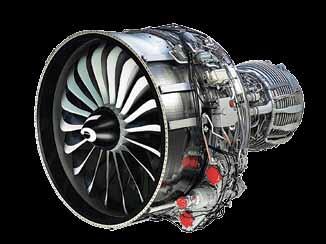
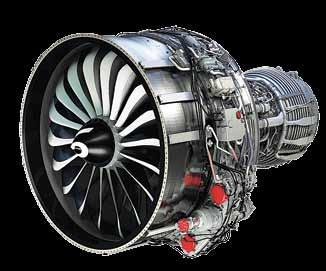
Demand for the CFM56 family is still strong. In 2016, the CFM56 programme reached record production rates and the manufacturer is sure that the production will continue until all current aircraft orders are filled. GE Aerospace and Safran Aircraft Engines will also continue to provide spare engines and parts, and comprehensive through-life support during the CFM56’s remaining service lifetime of over 30 years. SP

17 ISSUE 11 • 2022 www.sps-aviation.com EnginEs OEM
2005 2008 2016 2018 2004 2005 2013 2017 2019
Aircraft Engines Operators Hours Cycles
1,113 2,443 73
673
56
127
LEAP-1A A320neo
12,066,405 5,941,229 LEAP-1B 737 MAX
1,528
3,225,652 1,226,776 Total 1,786 3,971
15,292,057 7,168,005
Gulfstream announces G700 World tour
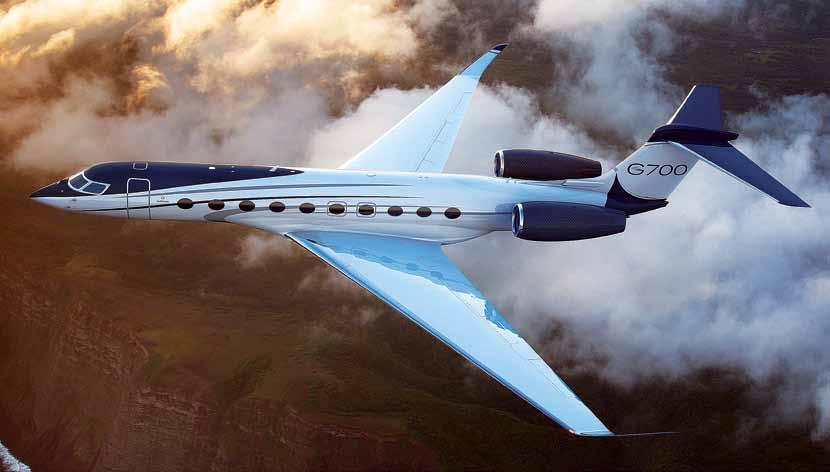
Two Fully Outfitted G700 Test Aircraft to be Showcased to Customers Across Continents
By Rohit Goel
Gulfstream announced on october 17, 2022 that the two fully outfitted Gulfstream G700 production test aircraft will embark on an extensive world tour to showcase Gulfstream’s flagship and the most spacious cabin in the industry to customers. The G700 world tour will commence directly after the two aircraft appear at the 2022 NBAA Business Aviation Convention & Exhibition (NBAA-BACE) and builds on the test programme’s impressive real-world performance capabilities, which already include eight international city-pair speed records.
FLYING ACROSS THE GLOBE
“These outfitted G700 aircraft currently flying feature two of the most stunning interiors in business aviation,” said Mark Burns, president, Gulfstream. “After being on display for the industry at NBAA-BACE in Orlando, Florida, the G700 will fly to major events and private showings across 20 cities and six continents as part of our efforts to give customers direct access to the aircraft. The strategic route of the G700 world tour reflects the strong demand we are seeing in established markets, such as
18 ISSUE 11 • 2022 www.sps-aviation.com Business AviAtion G700
Pho T o G ra P hs: Gulfs T ream
The G700 world Tour reflecTs The sTronG demand for The aircrafT from esTablished markeTs
Europe and the Middle East, and in growing markets for us, including Southeast Asia, India and Africa.”
The G700 world tour will take the aircraft to South America, Europe, Africa, Asia and Australia as well as events including the Future Investment Initiative in Riyadh, Saudi Arabia; the Bahrain International Airshow; and the Middle East & North Africa Business Aviation Association (MEBAA) Show in Dubai.
The first fully outfitted G700 production test aircraft first flew in April 2021 and was joined by the second outfitted aircraft this past September. The second G700 test aircraft will ensure the maturity, durability and comfort of more cabin elements that were introduced with the aircraft’s launch in 2019, including the all-new ultrahigh-definition dynamic circadian lighting system, an optional feature capable of replicating sunlight. The latest G700 outfitted aircraft also includes a grand suite and newly designed spacious lavatory with natural light, full vanity and shower, as well as a six-place dining area with a fully expandable, self-contained table.
Also, in September 2022, Gulfstream had announced their all-new Rolls-Royce Pearl 700 engines for the industry flagship Gulfstream G700 and ultralong-range Gulfstream G800 have achieved European Union Aviation Safety Agency (EASA) certification.
AWARD WINNING DESIGN
In the middle of 2022, the first outfitted G700 was awarded the
2022 International Yacht & Aviation Award in the Private Jet Design category for excellence in cabin design. The all-new seat design on the G700 earned an IY&AA in 2020. The G700 features the most spacious, innovative and flexible cabin in the business aviation industry. The G700 production-test interior features a tonal palette of light, creamy neutrals and warm grays contrasted by defining accents of cinnamon and charcoal. Each cabin living area is accentuated by design elements and a true circadian lighting system that creates optimal atmospheres to work, rest and connect, while putting you one step ahead of jet lag by simulating the sunlight of your next time zone. Complete with award-winning seat design, hand-tailored finishes and handcrafted furnishings, the G700 interior provides the utmost in passenger comfort. The flexibility of the G700 cabin offers nearly limitless interior design opportunities, along with the signature Gulfstream Cabin Experience. The G700 features the most spacious cabin in the industry and can fly at its high-speed cruise of Mach 0.90 for 6,400 nautical miles/11,853 kms or at its long-range cruise of Mach 0.85 for 7,500 nm/13,890 kms. The G700 includes the Gulfstream Symmetry Flight Deck with the industry’s only electronically linked active control sidesticks, the most extensive use of touch-screen technology in business aviation and Gulfstream’s award-winning Predictive Landing Performance System.
Also, Gulfstream has lowered cabin altitude for the all-new G700, further advancing the already industry-leading Gulfstream Cabin Experience on the new business jet flagship. Origi-
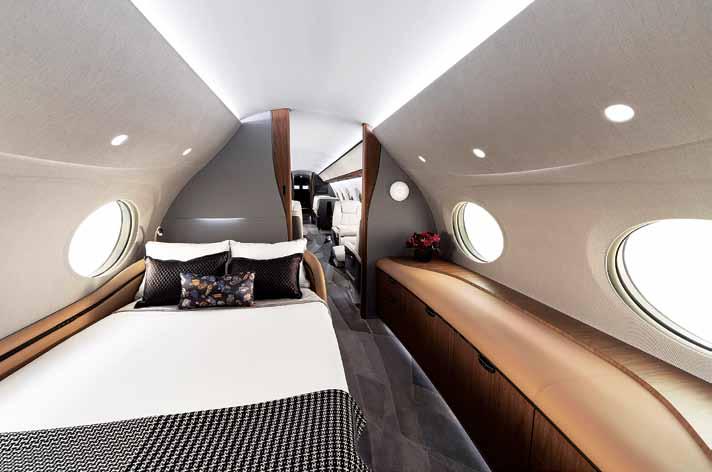
19 ISSUE 11 • 2022 www.sps-aviation.com Business AviAtion G700
G700 was awarded The 2022 inTernaTional YachT & aviaTion award in The PrivaTe JeT desiGn caTeGorY for excellence in cabin desiGn
G700 specificAtions
Performance
maximum range
7,500 nm | 13,890 km high-speed cruise mach 0.90 long-range cruise mach 0.85 maximum operating mach number (mmo) mach 0.925 Takeoff distance (sl, isa, mTow) 6,250 ft | 1,905 m
initial cruise altitude 41,000 ft | 12,497 m maximum cruise altitude 51,000 ft | 15,545 m
Measurements
finished cabin height 6 ft 3 in | 1.91 m finished cabin width 8 ft 2 in | 2.49 m cabin length (excluding baggage) 56 ft 11 in | 17.35 m
Total interior length 63 ft 8 in | 19.41 m cabin volume 2,603 cu ft | 73.71 cu m baggage compartment volume 195 cu ft | 5.52 cu m exterior length 109 ft 10 in | 33.48 m overall wingspan 103 ft | 31.39 m exterior height 25 ft 5 in | 7.75 m
Cabin Design
flexible cabin configuration
Galley/Galley annex or ultragalley with or without dedicated crew compartment forward and aft lavatories
Weights
maximum Takeoff
1,07,600 lb | 48,807 kg maximum landing 83,500 lb | 37,875 kg maximum Zero fuel 62,750 lb | 28,463 kg basic operating 56,365 lb | 25,567 kg maximum Payload 6,385 lb | 2,896 kg maximum Payload/full fuel 2,235 lb | 1,014 kg maximum fuel 49,400 lb | 22,407 kg
Systems
avionics: Gulfstream symmetry flight deck avionics: Predictive landing Performance system avionics: enhanced flight vision system with dual head-up displays avionics: synthetic vision with dual head-up displays and Primary flight display engines: Two rolls-royce Pearl 700 rated Take-off Thrust (each) 18,250 lb | 81.20 kn
Source: Gulfstream
Gulfstre Am G700 mAkes AsiA-pAcific DeBut in vietnAm
the all-new Gulfstream G700 made its Asia-pacific debut in vietnam as the first stop in asia on the G700 world tour. The G700 joined Gulfstream G600 and Gulfstream G650er at an exclusive event at van don international airport in Quang ninh Province, vietnam.
en route to vietnam the G700 set a new city-pair speed record, travelling from istanbul to van don airport, 4,573 nautical miles/8,469 kilometers in 9 hours and 2 minutes at an average speed of mach 0.90. “we are honored to bring the G700 to van don airport and showcase the industry leading performance and technology Gulfstream offers,” said mark burns, President, Gulfstream. “vietnam and southeast asia are strong developing markets for Gulfstream. as we see continued demand and fleet growth in the region, we are also bolstering resources to support customers there, including field service coverage from Gulfstream customer support and the Gulfstream fasT field and airborne support Teams.” SP
nally announced with a cabin altitude of 3,290 feet/1,003 meters when flying at 41,000 ft/12,497 m, the G700 cabin altitude at the same flight level has been improved to 2,916 ft/889 m. With this enhancement, the G700 retains its leadership position with the lowest cabin altitude in the business aviation industry. The G700 cabin, the most spacious in the industry, first took flight on April 15, 2021, on the first fully outfitted production test aircraft. Gulfstream is taking the G700 interior through more than 15,500 test points to ensure the cabin’s comfort, maturity and durability upon its entry into service. Gulfstream anticipates G700 customer deliveries beginning in the fourth quarter of 2022.
In addition to the low cabin altitude, The Gulfstream Cabin Experience on the G700 includes 100 per cent fresh, never recycled air; whisper-quiet noise levels; 20 of the industry’s largest windows; an all-new, high-definition circadian lighting system; and award-winning seat design with advanced ergonomics and a variety of enhanced comfort preferences customers can choose from.
COMMITMENT TO SUSTAINABILITY
The first outfitted G700 had already set eight international citypair speed records. The new industry flagship Gulfstream G700
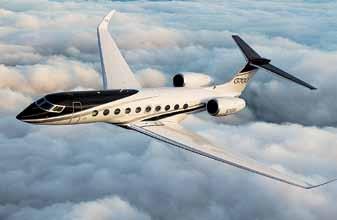
20 ISSUE 11 • 2022 www.sps-aviation.com Business AviAtion G700
set its seventh international city-pair speed record on May 20, 2022, en route to the European Business Aviation Convention & Exhibition in Geneva. In a demonstration of Gulfstream’s industry-leading sustainability commitment, the G700 flew the record flight on sustainable aviation fuel (SAF). The G700 linked Savannah, Georgia, to Geneva in 7 hours and 37 minutes at an average speed of Mach 0.90.
The G700 has set city-pair records on all its major international trips for customer viewings. In September, the fully outfitted production-test aircraft set speed records from Savannah to Doha, Qatar; from Doha to Paris; and from Paris back to Savannah. The G700 then made record-setting flights from Houston, Texas, to Riyadh, Saudi Arabia, and returned in record time from Riyadh to Savannah. The city-pair flights were made using a combination of SAF and carbon offsets to minimise environmental impacts.
The all-new Gulfstream G700 made great strides in its flighttest programme and capped 2021 with additional accomplishments, including the use of a sustainable aviation fuel (SAF) blend on 83 per cent of G700 flights launched from the Savannah-based Gulfstream Flight Test Center. “Getting this amazing aircraft in front of customers has been one of the highlights of 2021,” said Mark Burns, President, Gulfstream. “We are also further demonstrating our commitment to SAF by using the fuel blend as much as possible on G700 test flights — five out of six test aircraft have used the fuel blend on every flight. We look forward to building on these successes in 2022 and accomplishing even more programme milestones as we move closer to customer deliveries.”
Along with maintaining an industry-leading role in using
and promoting the safety, ease and performance capabilities of SAF, Gulfstream also supports the industry’s overall efforts to decrease carbon emissions by providing SAF to customers and being the first business-aviation manufacturer to sign the World Economic Forum’s Clean Skies for Tomorrow 2030 Ambition Statement. To date, Gulfstream has purchased more than 1.6 million gallons of the SAF blend for company and customer use.
Gulfstream underlined its sustainability goals that encompass three pillars: • energy and emissions, • operations, and • culture and learning.

Through these goals, Gulfstream has continued to maintain levels with industry goals established by the National Business Aviation Association (NBAA), the General Aviation Manufacturers Association (GAMA) and the International Business Aviation Council (IBAC) to curtail carbon emissions, revamp fuel efficiency and pursue carbon-neutral growth.
The aerospace company has been consistently making significant efforts towards sustainability. There are several elements to Gulfstream’s sustainability programme, including aircraft sustainability, eco-friendly buildings and the use of SAF for its corporate, demonstration, customer support and flight test fleets in Savannah. Gulfstream also gives an opportunity to its operators to decrease their carbon footprint with the carbon offsets programme, which is available through Gulfstream’s Aircraft Ownership Service and funds activities that generate an equal reduction in carbon emissions. SP
21 ISSUE 11 • 2022 www.sps-aviation.com Business AviAtion G700
Pho T o G ra P h: n a T l a ero / Twi TT er
naTional aeronauTic associaTion (naa) PresidenT & ceo GreG oTTo PresenTed GulfsTream wiTh 5 cerTificaTes aT nbaa for records recenTlY broken
Future oF Flight — Powered by ge
By Joseph NoroNha
With the threat of catastrophic climate change looming large, commercial aviation simply cannot continue on its present unsustainable trajectory. GE Aviation has therefore embarked on a comprehensive technology-based endeavour to slash aviation’s carbon emissions and rewrite the narrative.
A new refrain is animating General Electric these days: the “Future of Flight”. Were it to come from another enterprise it might sound clichéd. But not when it is GE Aviation, a subsidiary of General Electric, and maker of some of the world’s bestselling military and commercial engines. The history of General Electric, headquartered in Cincinnati, Ohio, goes back all of 105 years to 1917 – just 14 years after powered flight began.
The sweep of GE’s technology development roadmap under the “Future of Flight” is remarkably wide-ranging and momentous. It is part of what US Energy Secretary Jennifer Granholm calls an “all-in effort” to decarbonise aviation, which currently accounts for approximately 2.5 per cent of global carbon emissions – a figure that seems set to rise.
As a measure of General Electric’s determination to put aviation first, it announced a year ago that it would spin off its healthcare and energy businesses and make GE Aviation its main focus. GE Aviation will be rebranded as GE Aerospace by early 2024 to better reflect the new priorities. GE already fields
37,700 commercial aircraft engines and 26,500 military aircraft engines. However, the present campaign does not directly involve its military portfolio. GE’s commercial engines include the GE90, GE9X, GP7-200, CF-6 and GEnx. In addition, CFM International (CFMI), a 50-50 joint company between GE and Safran Aircraft Engines, manufactures the CFM56, the world’s bestselling turbofan, and its successor, the LEAP engine. So, what does GE think is the future of flight? In a word, it is ‘Sustainability’.
Seeking SuStainability
GE’s upcoming GE9X turbofan is the most fuel-efficient engine in its class. Over the coming years, GE also intends to demonstrate some key technologies and advanced engine architecture such as open fan and hybrid-electric propulsion systems, as well as new compact engine cores. It will also actively support the use of alternative fuels, such as Sustainable Aviation Fuel (SAF) and hydrogen, and harness digital technologies to help make the industry more sustainable.

22 ISSUE 11 • 2022 www.sps-aviation.com OEM Technology
The CFM RISe (RevoluTIonaRy InnovaTIon FoR SuSTaInable engIneS) pRogRaMMe goalS InClude ReduCIng Fuel ConSuMpTIon and Co2 eMISSIonS by MoRe Than 20 peR CenT aS well aS enSuRIng 100 peR CenT CoMpaTIbIlITy wITh alTeRnaTIveS lIke SaF and hydRogen. CFM InTeRnaTIonal IS a 50/50 joInT CoMpany beTween ge and SaFRan aIRCRaFT engIneS
p ho T og R aph S : ge
Since June 2021, GE has focussed on the next generation of engines and has launched three key demonstration programmes. First off the blocks was CFM’s RISE (Revolutionary Innovation for Sustainable Engines) Technology Demonstration Program, with its open fan configuration. Second, a partnership with the National Aeronautics and Space Administration (NASA) to develop a megawatt-class hybrid-electric propulsion system. Third, and most crucially, a partnership between Airbus and CFMI to conduct flight tests of a hydrogen-powered engine. Hydrogen is the only path to a true zero-emission aircraft and the genuine sustainability of aviation.
RiSe RiSing
Launched on June 14, 2021, RISE aims to produce a dramatically new generation gas-turbine engine design by around 2035. It mainly involves an advanced engine architecture – the open fan. Open fan designs have been tried in the past only to be abandoned. However, the technology now exists to overcome most of the known pitfalls, including noise. CFM RISE aims to achieve at least 20 per cent lower fuel consumption and CO2 emissions compared to today’s most efficient engines. Central to the programme is state-of-theart propulsive efficiency. CFMI intends to make the new engine compatible with 100 per cent SAF and capable of hybrid-electric operation. And with hydrogen being increasingly seen as the “fuel of the future” RISE will be adaptable to run on hydrogen.
CoRe iSSue
One of several enabling technologies included in RISE is a compact engine core. Shrinking the core increases the bypass ratio. Therefore, the engine generates more thrust for roughly the same fuel burn, making it more efficient. GE, in association with NASA, is in the process of testing and maturing new compact core designs, including compressor, combustor and high-pressure turbine to improve thermal efficiency. Ceramic Matrix Composites, an advanced, heatresistant material, is a key part of this effort to improve efficiency and reduce emissions.
eleCtRified PoweRtRain
In GE’s partnership with NASA to mature a megawatt class hybrid-electric powertrain, the testbed will be a Saab 340B commuter plane powered by two GE CT7-9B turboprop engines. Boeing and BAE Systems are other partners in this effort to demonstrate flight readiness for single-aisle aircraft powered by a hybrid-electric system.
Working with high voltages at high altitudes is extremely challenging because the rarefied air provides very little insulation. So additional insulation and more space between wires is essential to prevent arcing. At the Farnborough International Airshow in June 2022, GE and NASA jointly announced that they have become the first to successfully test high-power, high-voltage hybrid-electric engine components in conditions simulating altitudes up to 45,000 feet.
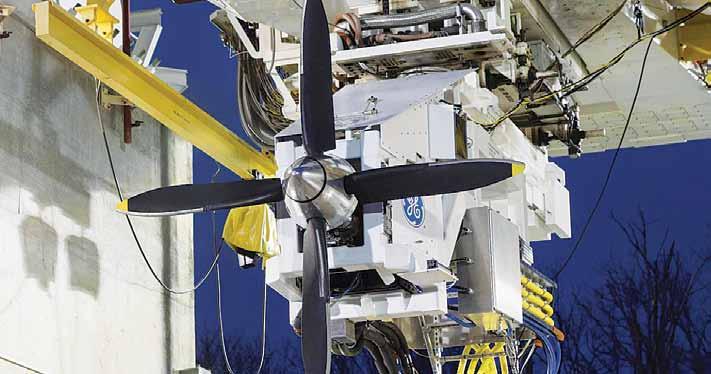
23 ISSUE 11 • 2022 www.sps-aviation.com OEM Technology
naSa and ge avIaTIon announCed a new paRTneRShIp To MaTuRe a MegawaTT-ClaSS hybRId eleCTRIC engIne ThaT Could poweR a SIngle-aISle aIRCRaFT
Although hydrogen poses huge challenges at every stage of production, storage and use, it offers the only realistic hope of making aviation emission free
Another problem is that weight reduction, a relentless quest of aircraft designers, is more difficult for an electrical system. Also the amount of energy that can be stored in airborne batteries is low, given the severe weight and space constraints of aircraft.

SimPly Saf
The International Air Transport Association (IATA) has set an ambitious target of making the airline industry “net zero” by 2050. Considering that annual worldwide airline passenger numbers are expected to double by 2050, this is a daunting proposition. The use of cleaner fuels is a key component of the strategy to reach the objective. Last year, the US government set two national SAF goals: annual production of three billion gallons by 2030 (a 600-fold increase from 2021) and 35 billion gallons by 2050. This would suffice to meet the entire projected US demand for aviation, and help dramatically reduce emissions associated with air travel in the world’s largest aviation market.
On December 1, 2021, a United Airlines Boeing 737 MAX 8 jet became the world’s first passenger flight to use 100 per cent SAF in one of its two CFM LEAP-1B engines. This was an important step in efforts to increase SAF use. Currently SAF is approved for aviation as a blend of normal Jet A or Jet A-1 fuel, and SAF with a maximum limit of 50 per cent. All GE and CFMI engines can operate with SAF which significantly lowers lifecycle carbon emissions compared to fossil fuels. Being “drop-in”, SAF can be used interchangeably with conventional fuel without modification to engines and airframes.
HoPeS ReSt on HydRogen
Hydrogen is not just the most abundant element in the universe but produces no CO2 when burnt. Measures like increased fuel efficiency, SAF and hybrid-electric planes can reduce but not eliminate emissions. Although hydrogen poses huge challenges at every stage of production, storage and use, it offers the only realistic hope of making aviation emission free.
In February 2022, CFMI signed an agreement with Airbus to collaborate on a hydrogen demonstration programme that will take flight around the middle of this decade. The engineers at CFMI are working to modify a GE Passport engine to make it fully compatible with liquid hydrogen fuel. This includes a complete overhaul of its combustor, fuel system and controls system. The modified jet engine will be mounted on the rear top of the fuselage of an Airbus A380, powered by its original four engines. But the experimental configuration will allow the team to test the hydrogen-powered engine’s emissions, including contrails, and monitor them separately. This is in preparation for entry-into-service of a hydrogen-fuelled commercial aircraft by 2035.
SuStainability StRategieS
With the threat of catastrophic climate change looming large, commercial aviation simply cannot continue on its present unsustainable trajectory. GE Aviation has therefore embarked on a comprehensive technology-based endeavour to slash aviation’s carbon emissions and rewrite the narrative. GE has already proved that even current airliners have immense potential to reduce emissions. In late 2021, an Etihad Airways Boeing 787 flight from London to Abu Dhabi cut its normal carbon emissions by 72 per cent using SAF and employing innovative route planning to avoid creating contrails. The plane was powered by GE’s GEnx engines and used GE Digital’s Fuel Insight software to analyse data and make fuel-saving adjustments within minutes. It had also used GE’s 360 Foam Wash,
(Top) aIRbuS and CFM InTeRnaTIonal (a 50/50 joInT CoMpany beTween ge and SaFRan aIRCRaFT engIneS) SaId They’ll CollaboRaTe on TeSTS oF an aIRCRaFT engIne Fueled by hydRogen; (above) ge ReSeaRCh IS SeekIng To deSIgn an eleCTRICITy-dRIven pRopulSIon SySTeM boTh poweRFul and lIghT enough To keep aloFT a 1,75,000-pound CoMMeRCIal aIRlIneR and ITS 175 paSSengeRS
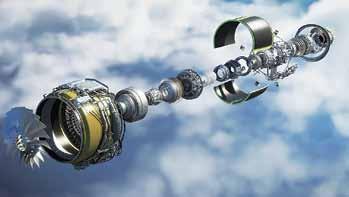
a cleaning system that helps improve engine performance and reduce fuel consumption by removing dust and dirt from inside the engine. Ultimately, every ounce of effort counts.
Recently, GE Chief Sustainability Officer Roger Martella was asked to describe what the future of flight might look like. In response, he invited his audience to step into his time machine. “If you go to the airport today,” he said, “you can be pretty confident there’s going to be an airplane there with probably two engines on it using jet fuel.” But looking only ten years down the road, “you may have an airplane that’s using SAF, you may have an airplane that’s a hybrid electric, you may have one that has an open fan, you may have one that runs on hydrogen” – all solutions that GE Aviation is working on. If GE’s sustainability efforts bear fruit, the future of flight may be here sooner than we imagine. SP
24 ISSUE 11 • 2022 www.sps-aviation.com
Technology
OEM
Indo-French exercIse Garuda VII
The exercise provided a platform for both the countries to enhance operational capability and interoperability, while also sharing best practices
By Rohit Goel
indian air Force (iaF) and French air and Space Force (FASF) participated in a bilateral exercise, named ‘Garuda VII’, from October 26 to November 12, 2022 at Air Force Station Jodhpur. In this exercise, FASF participated with four Rafale fighter aircraft, one A330 Multi Role Tanker Transport (MRTT) aircraft and a contingent of 220 personnel. The IAF participation was with Su-30 MKI, Rafale, LCA Tejas and Jaguar fighter aircraft, as well as the Light Combat Helicopter (LCH) and Mi-17 helicopters. The IAF contingent also included Combat Enabling Assets like Flight Refuelling Aircraft, AWACS and AEW&C.
This is the seventh edition of the bilateral exercise. The first, third and fifth editions were conducted in India in 2003, 2006 and 2014 at Air Force Stations Gwalior, Kalaikunda and Jodhpur, respectively. The second, fourth and sixth editions were conducted in France in 2005, 2010 and 2019.
Ex Garuda VII is also the first occasion for the LCA Tejas and the recently inducted LCH Prachanda to participate in any international exercise. The exercise, which culminated on November 12, 2022, includes four FASF Rafale fighters and one A330 Multi Role Tanker Transport (MRTT) aircraft. Apart
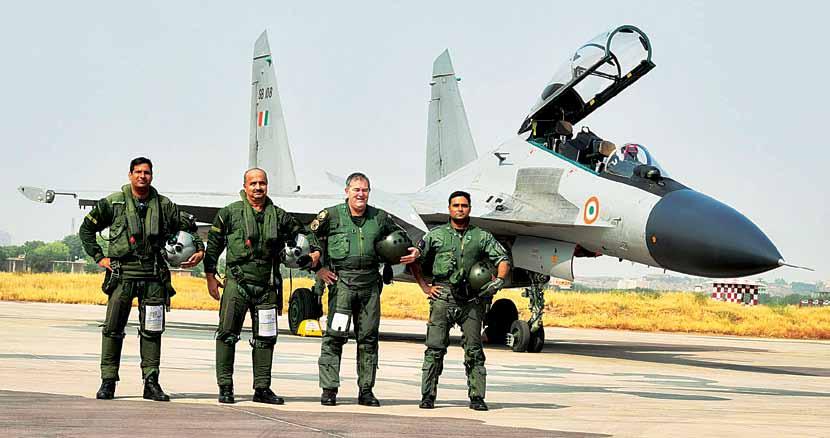
25 ISSUE 11 • 2022 www.sps-aviation.com Military ExErcisE Garuda Vii
p hoto G r A ph S : A f _MCC / t witter
Chief of the Air StAff of iAf Air Chief MArShAl V.r. ChAudhAri And Chief of the Air StAff of fASf, GenerAl StéphAne Mille flew SortieS in the exerCiSe
and FaSF ChiEFS Fly aS part oF Ex Garuda Vii
from the LCA and LCH, the IAF contingent consists of Su-30 MKI, Rafale and Jaguar fighter aircraft, as well as Mi-17 helicopters. The IAF contingent also includes Combat Enabling Assets like Flight Refuelling Aircraft, AWACS, AEW&C and Garud Special Forces.
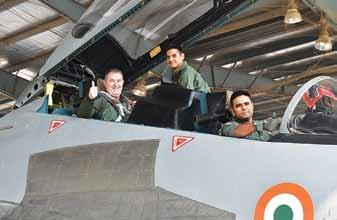
Exercise Garuda VII provided the two Air Forces with the opportunity for professional interaction and sharing of operational knowledge and experience. With meticulous planning and execution of various phases of the exercise, personnel of the IAF and the FASF were exposed to realistic air combat
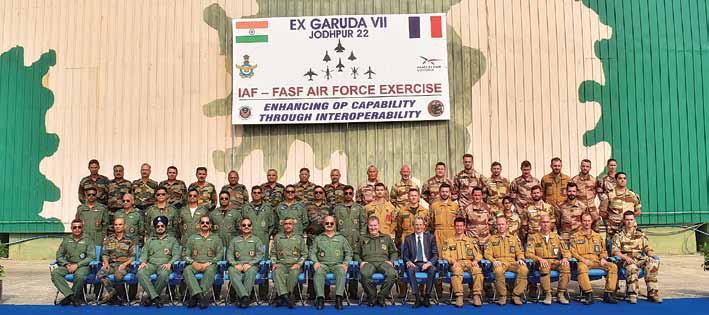
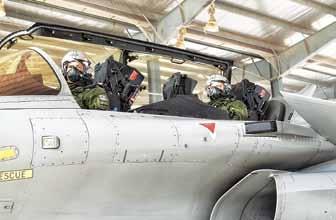
Speaking to the media later, along with the fASf Chief, indian Chief of the Air Staff (CAS) brought out that ex Garuda provides the unique opportunity for both Air forces to learn and imbibe best practices of each other during operations. he also highlighted the growing interoperability between both air forces, which has been developing with each successive edition of the exercise, a regular bilateral exercise since 2003. SP
simulations and the associated Combat Support Operations. This enabled the participating contingents to engage in wide ranging interactions, providing valuable insight into each other’s best practices.
Participation of the IAF and FASF in this exercise promoted professional interaction, exchange of experiences and enhancement of operational knowledge, besides strengthening bilateral relations between the two countries. The exercise also provided a platform for cultural exchange between the Air Force personnel of both the countries. SP
26 ISSUE 11 • 2022 www.sps-aviation.com Military ExErcisE Garuda Vii
Exercise Garuda Vii between indian air Force (iaF) and french Air and Space force (fASf) witnessed combined flying by Chief of the Air Staff (CAS) of iAf, Air Chief Marshal V.r. Chaudhari, and Chief of the Air Staff of fASf, General Stéphane Mille. while CAS flew a sortie in an iAf rafale fighter, the fASf Chief flew in an iAf Su-30 MKi fighter. Both participated in the exercise as part of a combined training mission which was flown from Air force Station Jodhpur.
iaF
China’s Display of Military Might
Since its inception in 1996, Airshow China has become an important window for showcasing advanced military, aviation and aerospace technologies developed by China
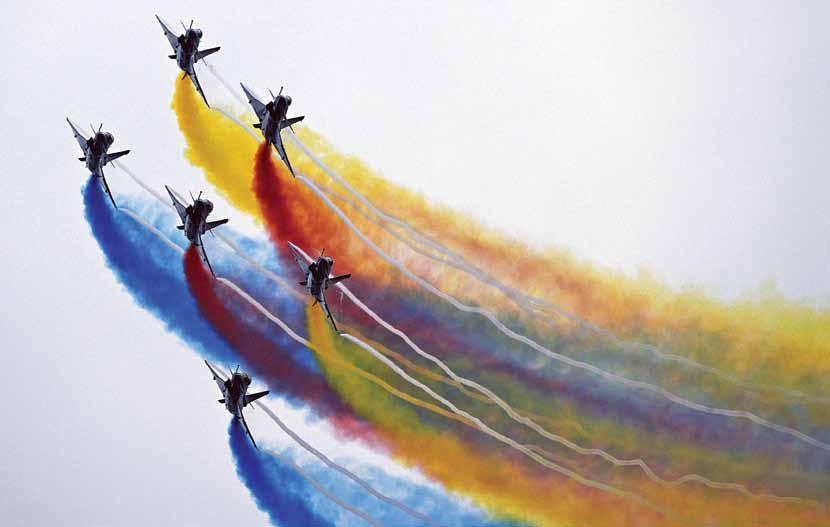 By Rohit Goel
By Rohit Goel
the airshow China 2022, the 14th China international Aviation and Aerospace Exhibition, was held in Zhuhai in China’s Guangdong Province. More than 740 domestic and overseas enterprises from 43 countries and regions participated in the exhibition on-site or online to display new technologies and new products in aerospace and national defence. A total of over 100 aircraft participated in the event parked outdoors, and the indoor exhibition area covered over 10 thousand square meters. The PLA Air Force (PLAAF) static exhibition area increased by 10 per cent compared with the previous edition of the show. Even the flight performance and ground equipment demonstration were more true-to-life experience compared with previous ones.
At this air show, weapons and equipment such as J-20 stealth fighter jets, Y-20 heavy transport aircraft, KJ-500 airborne early
warning (AEW) aircraft, H-6K bombers, HQ-9B air-defence missile system, Z-20 medium-lift utility helicopters, YU-20 tanker aircraft, J-16 fighter jets, and Attack-2 unmanned aerial vehicles (UAVs) were unveiled, and the Bayi Aerobatics Team of the PLAAF and the Red Eagle Aerobatic Team of the PLAAF Aviation University also performed aerobatic stunts in Zhuhai. They are among the 50 types of weapons the People’s Liberation Army Air Force had send to this year’s air show to highlight equipment put into service since 2000. The J-20 was on display on the ground for the first time, along with other “20 series” aircraft such as the Y-20 heavy lifter and Z-20 helicopter. There was a bewildering array of weapons, vehicles, helicopters and aircraft as Chinese industry seeks to meet the needs of the rapidly modernising People’s Liberation Army and to capture lucrative export markets. China also
27 ISSUE 11 • 2022 www.sps-aviation.com Military Airshow ChinA 2022
p hotograph: eng. C hinamil. C om. C n / y u h ong C hun
China’s Bayi aeroBatiC team performs aerial maneuvers on the opening day of the 14th airshow China in Zhuhai, on novemBer 8, 2022
p hotographs: eng. C hinamil. C om. C n / Zhang y ong J in, eng. C hinamil. C om. C n / d eng h ua, eng. C hinamil. C om. C n / l iu d awei
unveiled a life-size replica of China’s orbiting Tiangong space station, and Commercial Aircraft Corporation of China, Ltd (COMAC) received new orders for 300 C919 passenger aircraft.
FIGHTERS AND MISSILES
At the show, a YY-20 aerial tanker, the J-16 fighter and a Wing Loong 2 UAV all made their flying debut. Also on display was the very important Z-20 helicopter, a Chinese facsimile of the American Black Hawk. The airshow also featured other aircraft and weapons including the H-6K bomber and HQ-9B surfaceto-air missiles. After six days of intensive flying display performances, the J-20 fighter jets showcased its strengths that reflect the stealth aircraft’s strong and increasing combat capabilities. It is expected that the J-20 will enhance its manoeuvrability with new engines with thrust vectoring control. Taihang series turbofan engines with 2D and 3D thrust vectoring control nozzles were also on display at the Airshow China 2022. Another highlight of the J-20s’ display at this year’s air show was their landings and take-offs, in front of the general public for the first time, confirming that the runway distance required for the J-20 to take off and land is very short. This is of tactical significance because in combat, using only a small portion of runway to take off and land can greatly increase the warplane’s operational capability.
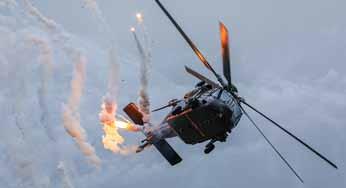
China also revealed several of its latest air defence missile and laser systems at the Airshow. The HQ-9B surface-to-air missile weapon system of the Chinese People’s Liberation Army (PLA) Air Force on display at the Airshow China featured for the first time a new type of missile in addition to the previously known one. Eight of this new type of missile can be carried by the same transporter erector launcher that can carry four of the previously known type, as the new missile is about the
same length but obviously thinner than the old one. The larger missiles will be used to intercept targets farther away, and if remaining targets come closer, the smaller missiles can be used.
Another new air defence system, the HQ-11 universal terminal defence system, made its debut at the airshow. It consists of a vehicle equipped with eight missile vertical launch cells and another vehicle equipped with a close-in gun. Both vehicles are equipped with corresponding radar systems. The HQ-11 is designed to cover a shorter range than the HQ-9B, but it is very fast and mobile so that it can accompany valuable assets on the move. It can intercept air-to-surface missiles, guided bombs, cruise missiles and other aerial weapons like fixed-wing aircraft and helicopters.
China also for the first time unveiled its fourth-generation advanced air defence equipment, the HQ-16FE mid- to longrange air defence missile weapon system. Developed by the Eighth Academy of the state-owned China Aerospace Science and Technology Corp, the system’s transporter erector launcher can carry six missiles at a time. The HQ-16FE can intercept multiple types of targets including manned aircraft, drones, cruise missiles and tactical ballistic missiles in a very intelligent and aggressive manner. Compared with its predecessors, the HQ-16FE has a longer range and a stronger anti-deception capability.
Together with the air defence missiles, a type of vehiclemounted tactical laser weapon of the PLA Air Force also made its debut at the airshow. It is a new type of combat force that targets low, slow, small targets like drones. It can either operate alone or form a network of multiple vehicles, or become a part of a larger air defence weapon system.
China is building a world-class comprehensive air defence system that can safeguard the country’s sky from potential attacks. The air defence systems displayed by the PLA Air Force
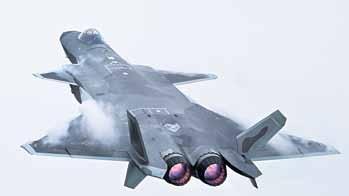
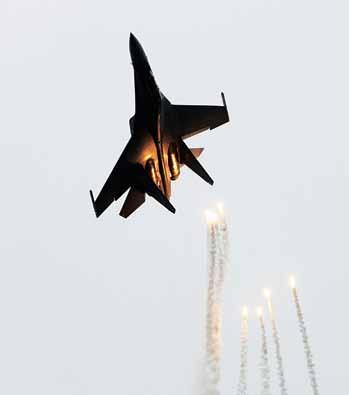
28 ISSUE 11 • 2022 www.sps-aviation.com Military Airshow ChinA 2022
flying DiSPlAy AT THE AiRSHOW: (CloCkwise from left) J-16 fighter on the opening day; J-20 fighter soars in the air; demonstration By Z-20 heliCopter.
at the Airshow China 2022 showed that China’s air defence weapons no longer rely on imports.
UNMANNED SYSTESM
China showed a wide range of unmanned aerial vehicles (UAV), ground vehicles and unmanned sea vessels that can work independently or with other manned systems. China is famous for its vast array of UAVs, the two most famous families being the Wing Loong and CH/Rainbow families of armed UAVs.
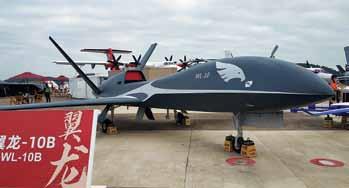
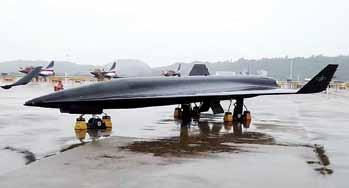

China unveiled its latest military drone model – Wing Loong-3, the first to reach intercontinental range while equipped for aerial self-defence. The WL-3 also features a stronger strike capability with as many as 16 missiles and bombs. Other new drones in the Wing Loong family – including the Wing Loong-1E and Wing Loong-10A – also made their debut. The China Aerospace Science and Technology Corp (CASC) displayed an improved CH-7 stealth UAV with a 26m wingspan and maximum take-off weight of 10 tonnes. Another mysterious stealthy UAV was the Cloud Shadow CS-5000T with blended wing design. Another newcomer was a near-space hypersonic technology testbed called the MD-22.
Air show China also offered a rare glimpse into its latest unmanned maritime vehicles. China State Shipbuilding Corporation (CSSC) displayed a variety of unmanned underwater vehicles (UUVs) at the air show, in numbers far exceeding those unveiled at previous editions of the biennial event. These included the Haishen 6000 (Poseidon 6000), a 7.6 metre-long UUV with a displacement of 3 tonnes, a maximum working depth of 6,000 metres (19,700 feet) and able to reach speeds of up to 4 knots. Multiple sensors on board can help it detect mines, and it can also carry towed acoustic decoys that use sonar signals to deflect active torpedoes.
Also showcased for the first time was the CSSC’s recently released EA63, a remotely operated vehicle built to be stationed on surface ships for mine-sweeping action, able to detect and neutralise marine mines both at depth and on the seabed. Two unmanned coastal defence vessels, the L30 Watcher and M75 Protector, were also displayed, both produced by Yunzhou, a Zhuhai-based technology company.
China’s most advanced anti-drone defence systems were one of the features of the air show. The systems are designed to detect and intercept swarms of unmanned aerial vehicles (UAVs) at low altitudes and combine air-defensive, artificial intelligence and anti-missile technology. State-owned China Aerospace Science and Industry Corporation (CASIC), said its system, the ZR-1500, integrated early-warning detection, command and control, as well as interception missiles. The system combined portable missiles from the PLA’s active HQ-17AE short-range missile defences, sophisticated radars, and its multiple purpose unmanned vehicle to form a “cost-saving, tight, dragnet defensive network to detect and intercept incoming aircraft and drones”.
CONCLUSION
This year’s airshow displayed a wide spread of China’s achievements in aerospace and defence technologies over the past decade. According to official sources, the 14th Airshow China 2022, concluded on November 13 in Zhuhai, China saw the signing of business deals worth $39.8 billion. As China continues its march towards total self-reliance in science and technologies for military use, the world will look forward to the 15th China International Aviation & Aerospace Exhibition which will be held in Zhuhai from November 12 to 17, 2024. SP
29 ISSUE 11 • 2022 www.sps-aviation.com Military Airshow
ChinA 2022
p hotographs: l oong uav, w ikimedia Commons / i nfinty0
On DiSPlAy AT THE AiRSHOW: (CloCkwise from top) loong 5 small military BomBing drone; wing loong-10B; wZ-8 ComBat drone
Bring on the Boeings!
The Boeing 707 ushered in a dramatic transformation in long distance air travel. It was ordered by a number of leading airlines across the globe, including Air India.
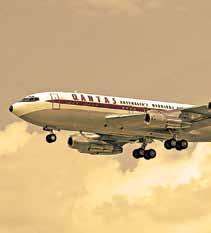
The world’s first successful turbojet-powered aircraft, the Heinkel He 178, made its first flight on August 27, 1939, just prior to the outbreak of World War II. However, the German military leadership failed to appreciate the tremendous potential of this new technology. The United States and Britain also developed fighter jets during the War, but they were not operationally deployed. Thereafter, it took a few years for the War’s dust to settle before aircraft manufacturers turned their attention to commercial jets.
At that time airliners were propeller-driven planes and were rather slow, small and at the mercy of the weather. Therefore British, French and Soviet technologists began striving to design and build passenger jet planes. The 36-seat British de Havilland DH 106 Comet, the world’s first production commercial jetliner, began scheduled service with British Overseas Airways Corporation (BOAC) from London to Johannesburg in May 1952. But a few tragic accidents, mainly on account of metal fatigue exacerbated by the square window design, soon forced its premature withdrawal from service.
Also in 1952, Boeing commenced work on a prototype jet aircraft that could be used both for aerial refuelling of military aircraft and as a commercial airliner. It was designated the Model 367-80 or simply Dash 80. It had a tube-and-wing configuration that became the standard for jet transport aircraft. Powered by four underslung Pratt & Whitney JT3 turbojets, each producing 10,000 lbf (44 kN) thrust, it could reach a top speed of 600 miles per hour (960 km/h).
The Boeing 707-120 was built by widening the Dash 80 to hold six seats abreast and stretching it to take between 140 and 179 passengers depending on the specific configuration and facilities desired by each airline. Its first flight was on December 20, 1957. The wings were swept back at 35 degrees. While this helped it to achieve higher cruise speeds, it also gave it an inherently unstable and potentially dangerous “Dutch roll” tendency that manifested itself as an alternating yawing and rolling motion. The aircraft was fitted with a yaw damper but any malfunction of the system or inadvertent disengagement by the crew could prove hazardous. A fatal accident during a customer acceptance check was attributed to this factor. Later variants like the Boeing 707-320C, the most popular of all 707s, could seat up to 194 passengers. It was powered by the more powerful and fuel-efficient P&W JT3D turbofan.
In 1955 Pan American World Airways (Pan Am) contracted to purchase 20 Boeing 707s and became its launch customer. Simultaneously it ordered 25 Douglas DC-8s, a similar jet airliner being developed by the Douglas Aircraft Company. Till then Douglas had dominated the commercial space, supplying airlines with most of their piston-engine passenger planes. However, the Boeing 707 was faster than the DC-8, and Boeing was willing to customise the plane to meet the airlines’ preferences. On October 26, 1958, the first scheduled jet passenger flight of the B707 took place with Pan Am’s transatlantic service from New York to Paris. Travellers found the new jet comfortable, less noisy, and far swifter than the leisurely propeller-driven airliners that had crisscrossed the skies for almost four decades. It was also much larger and smoother. It helped Pan Am steal a march over its rivals in the highly competitive intercontinental air travel market. In fact, the Boeing 707 ushered in a dramatic transformation in long distance air travel. It was ordered by a number of leading airlines across the globe, including Air India.
To handle the large, fast, high capacity jets, changes had to be made in airport terminals, runways, airline catering, baggage handling, reservation systems, and air traffic control. Pan Am later emerged as the most prolific operator of the 707, with 133 aircraft and the Boeing 707 became the most popular airliner of the day. In America a well-known slogan went, “If it ain’t Boeing, I ain’t going!”
Boeing manufactured a total of 1010 707s of different variants for commercial use till 1978, and another 800 for military customers till 1991. The US Air Force still operates a small fleet of Boeing 707s, testimony to the exceptional standard of this pioneering jet. However, with green aviation now being the buzz phrase, a Boeing 707 airliner would be roundly condemned as a noisy fuel guzzler. But in its day, it rejuvenated the commercial aviation space. It continued in airline service with Tier-2 carriers till as recently as 2013. It was not the first jet airliner but it was certainly the first commercially successful one. It did not earn Boeing any profit but it dominated the air routes for most of the 1960s. Building on this sweet success, Boeing rapidly achieved global dominance of the market with its 737s and 747s. At one point, almost three fourths of all airliners in the world were Boeings. SP
— Joseph NoroNha
hall of fame 30 ISSUE 11 • 2022 www.sps-aviation.com
sPACe
ASIA-PACIFIC
Launch of IndIa’s maIden prIvate vIkramsuborbItaL (vks) rocket
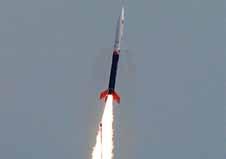
GIRIdhAR ARAMANe AssuMes The offICe of defeNCe seCReTARY

Giridhar Aramane, a 1988-batch Indian Administrative Service (IAS) officer of Andhra Pradesh cadre, assumed the office of Defence Secretary on November 1, 2022. Before taking charge, Aramane laid a wreath at National War Memorial in New Delhi and paid homage to the fallen heroes. He saluted the bravehearts who sacrificed their lives while protecting the nation.
“We draw inspiration from these bravehearts and promise to work towards fulfilling their dream of making India a safe & prosperous country,” Aramane said during his visit to the National War Memorial.
Indian Space Research Organisation (ISRO) made history today by launching successfully India’s maiden private Vikram-suborbital (VKS) rocket. Union Minister of Science and Technology and MoS PMO, Atomic Energy and Space, Dr Jitendra Singh witnessed the momentous occasion from Sriharikota, Andhra Pradesh.
Dr Jitendra Singh said, ISRO has added another feather in its glorious Space Journey, setting a new milestone in the 75 years history of independent India. The Minister said, the launch has put India among the frontline Space Powers of the World and many aspiring countries will look forward to take cues from Indian expertise. He described this as a major milestone after Prime Minister Narendra Modi had unlocked the Space Sector in India two years ago for private participation.
Dr Jitendra Singh informed that Vikram-S is a single stage fuel rocket meant to test most systems and processes in Skyroot Aerospace’s project ahead of the launch of Vikram-1 next year. He said, the rocket goes to the max altitude of 81.5 kilometres and splashes into the sea and the overall duration of launch is about 300 seconds only.
Dr Jitendra Singh said that Skyroot was the first StartUp to sign a MoU with ISRO for launching its rockets. He said, apart from being the nation’s first private launch, it is also the maiden mission of Skyroot Aerospace, named “Prarambh”. ISRO said in a statement that Mission Prarambh is successfully accomplished, while the Skyroot Aerospace said that Vikram-S makes history as the first private rocket of India to grace the skies. It carried a total of three payloads in space, including one from the foreign customers.
In his 32 years of experience in IAS, Aramane has held various important portfolios in the Central Government as well as Andhra Pradesh government. Prior to his current assignment, Aramane was Secretary, Ministry of Road Transport & Highways.
Earlier, he was Additional Secretary in the Cabinet Secretariat. Apart from Cabinet Secretariat, Aramane looked after Exploration Division in the Ministry of Petroleum & Natural Gas and was Executive Director in-
APPoIntment
Embra E r
charge of inspections in Insurance Regulatory & Development Authority.
In the Andhra Pradesh Government, Aramane had served as Principal Secretary in Urban Development Department; Managing Director of AP State Finance Corporation and Secretary (Finance Department). He also held the post of the Collector & DM of Chittoor and Khammam districts.
Aramane did B.Tech in Civil Engineering from Jawaharlal Nehru Technological University, Hyderabad and M Tech from IIT, Madras. He is MA (Economics) from Kakatiya University, Warangal. SP
Embraer announced the appointed of the current Chief Commercial Officer of Embraer Defence & Security, Bosco da Costa Júnior as the President and CEO of Embraer Defense & Security. He will take over from Jackson Schneider, who has decided to leave the company in April 2023, when his term ends.
Bosco joined Embraer in 2005. During his career at the company, he has held leadership positions in the areas of contract management, proposals, industrial cooperation/offset in Defence, and various managerial roles in the procurement and supply chain management areas.

MILITARY
ASIA-PACIFIC
Western aIr command commanders’ conference
Conference was held on November 10-11, 2022 at New Delhi. Air Chief Marshal V.R. Chaudhari, Chief of the Air Staff (CAS) was the Chief Guest during the conference. In his address, CAS emphasised the need for maintaining Op preparedness, serviceability of assets and ensuring physical and information security. Enhancing the IAF’s operational capability through force structuring, self-reliance and indigenisation was the key to being future-ready, he added. The CAS directed all Commanders present to ensure the operational readiness of all platforms, weapon systems and assets, at all times. l

News digest 31 ISSUE 11 • 2022 www.sps-aviation.com
Western Air Command Commanders’
Training is ViTal & CriTiCal
The seventh edition of bilateral Air Exercise Garuda VII between the Indian Air Force (IAF) and French Air and Space Force (FASF) concluded on November 12 at Air Force Station Jodhpur. The 18 day air exercise began on October 26.
In this exercise, FASF participated with four Rafale fighter aircraft, one A330 Multi Role Tanker Transport (MRTT) aircraft and a contingent of 220 personnel. The IAF participated with Su-30 MKI, Rafale, LCA Tejas and Jaguar fighter aircraft, as well as the Light Combat Helicopter (LCH) and Mi-17 helicopters. The IAF contingent also included Combat Enabling Assets like Flight Refuelling Aircraft, AWACS and AEW&C. This was the first occasion for the LCA Tejas and the recently inducted LCH Prachanda to participate in any international exercise.
According due importance to exercises of such stature, November 8 witnessed combined flying by IAF Chief of the Air Staff (CAS), Air Chief Marshal V.R. Chaudhari, and Chief of the Air Staff of FASF, General Stéphane Mille, participated in the exercise as part of a combined training mission. The IAF CAS flew a sortie in an IAF Rafale fighter and the FASF Chief flew in an IAF Su-30MKI fighter.
The IAF CAS said, “We have learned how to carry forward our interoperability. French Air Force also flies Rafale, we also fly Rafale, but we fly many other aircraft along with Rafale. It’s important to learn how to interoperate with friendly nations.”
So far, three editions of Exercise Garuda have been conducted in India in 2003, 2006 and 2014 at Air Force Stations Gwalior, Kalaikunda and Jodhpur, respectively. Intervening three editions were conducted in France in 2005, 2010 and 2019.
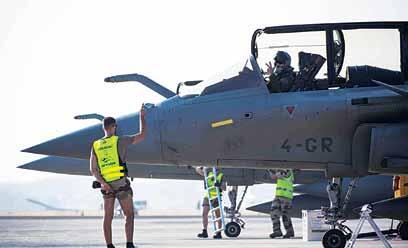

In any future conflict anywhere in the globe, air power will play a vital and critical role in deciding the outcomes of the conflict. Such exercises provide great opportunity in enhancing inter-operability, developing trust, demonstration of capabili-
By Air Vice MArshAl sAnjAy BhAtnAgAr (retd)
ties, camaraderie and familiarity between the operating Air Forces. Multinational exercises are aimed at promoting inter operability, checking readiness of forces and strengthening understanding among participating forces. It facilitates better coordination between the militaries, observation of enemy’s tactics, familiarisation with new technologies, enabling on-the-job training of participating crew.
Besides these military exercises are a good tool of strategic signaling and projection of intent. Deployment of air power in a multinational exercise sends even a stronger signal. IAF has assumed a leadership role in this regard and has been carrying out exercises with various countries.
These exercises also have a great potential towards enhancing military diplomacy. IAF has been cognizant of important role the air exercises play in furthering military diplomacy and has been taking part in various air exercises with nations like the US, Russia, the UK, France, Israel, UAE, Japan, Singapore, South Korea, Malaysia and Australia. Most of these exercises are regular and scheduled.
At the same time there is also a need for IAF to engage in air exercises with our neighbouring countries - Bangladesh, Nepal, Sri Lanka and Afghanistan, with whom there are more likelihood, especially of the IAF getting involved as lead agency for human assistance in disaster relief (HADR) operations. IAF annually conducts a joint HADR exercise with ASEAN countries, this year it is planned in Air Force Station Agra from 28–30 November, 2022.
For IAF, collaboration in the Indo-Pacific region is the key driving theme of the exercise. Exercise Garuda VII assumes even more significance in view of the prevailing geopolitical situation, especially in the Indo-Pacific region. IAF needs to continue to train vigorously to enhance its operational capability and technical competence through such exercises. SP
LAST word 32 ISSUE 11 • 2022 www.sps-aviation.com
Multinational exercises are aimed at promoting interoperability, checking readiness of forces, familiarisation with new technologies and enabling on-the-job training of participating crew
Photogra P hs: a F_MCC / t w tter
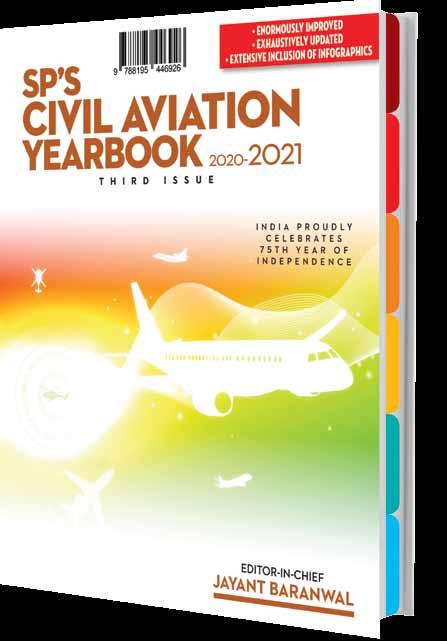

GET YOUR COPIES, NOW: E-mail us at: order@spscivilaviationyearbook.com WhatsApp us at: +91 97119 33343 Call us on +91 11 24644693, 24644763, 24620130, 24658322
FIRSTOFITSKIND
A clear choice
As an industry, we have committed to reaching net-zero carbon emissions by 2050. With customers seeing a 15 to 20+% reduction in CO2 emissions*, the LEAP engine family is a clear choice today for a more sustainable tomorrow. Extraordinary together.

cfmaeroengines.com/sustainability

CFM International is a 50/50 joint company between GE and Safran Aircraft Engines
*Compared to previous generation engines.






















 By Rohit Goel
By Rohit Goel























 By Rohit Goel
By Rohit Goel



























